Aircraft Wings and Morphing–Evolution of the Concepts
Definition
1. Introduction
2. Terminology and Basic Concepts
- Chord line—the straight line connecting LE and TE of an airfoil,
- Mean camber line—the locus of points that are halfway between the upper and lower surfaces of the airfoil, and
- Camber refers to the maximum distance between the mean camber line and the chord line, measured perpendicular to the last one.
- chord length of the airfoil section
- lift per unit length of the airfoil
- drag per unit length of the airfoil
- pitching moment per unit length acting on the airfoil (at the aerodynamic center, quarter-chord, or another relevant point)
3. Patents
3.1. Morphing and Related Topics Subsection
3.2. Leading Edge Protection, Damage, and Replacement
3.3. Wing Control Surfaces
3.4. Trailing Edge Innovations
4. Morphing
4.1. Technologies
4.2. Aerodynamic Loads
4.3. Materials and Fatigue
4.4. Examples of Demonstrators
4.5. Biomimetics
4.6. Sinthetizing
5. Concluding Remarks
Funding
Institutional Review Board Statement
Informed Consent Statement
Data Availability Statement
Conflicts of Interest
Abbreviations
| AAWC | Active Adaptive Wing Camber |
| ACTE | adaptive compliant trailing edge |
| ADIF | Adaptiver Flügel (DLR project) |
| AFRL | Air Force Research Laboratory (US) |
| AFTI | advanced fighter technology integration |
| AFWAL | Air Force Wright Aeronautical Laboratories (US) |
| AHS | American Helicopter Society (US) |
| AI | artificial intelligence |
| AIAA | American Institute of Aeronautics and Astronautics (US) |
| ALM | additive layer manufacturing |
| ASC | American Society for Composites (US) |
| ASCE | American Society of Civil Engineers (US) |
| ASME | American Society of Mechanical Engineers (US) |
| CFD | computational fluid dynamics |
| CNATRA | Chief of Naval Air Training (US) |
| DARPA | Defense Advanced Research Projects Agency (US) |
| DLR | Deutschen Zentrum für Luft- und Raumfahrt |
| EAP | elastic-active polymer |
| EP | European patent |
| FCG | fatigue crack growth |
| FEA | finite element analysis |
| FEM | finite element method |
| FEUP | Faculdade de Engenharia da Universidade do Porto |
| FGM | functionally graded material |
| GRA | Green Regional Aircraft (subprogram of Clean Sky) |
| H2020 | EU research and innovation programme 2014—2020 |
| IADP | integrated advanced demonstrator project (Clean Sky) |
| ICAO | International Civil Aviation Organization (UN) |
| IMechE | Institution of Mechanical Engineers (UK) |
| ISBN | international standard book number |
| ITD | integrated technological demonstrator (Clean Sky) |
| KR | Republic of Korea |
| LE | leading edge |
| LEISA | Leiser Start und Anflug (project) |
| MAS | Morphing Aircraft Structures (DARPA project) |
| MAW | mission adaptive wing |
| MDAO | multidisciplinary design analysis and optimization |
| MIT | Massachusetts Institute of Technology |
| NACA | National Advisory Committee for Aeronautics (predecessor of NASA) |
| NASA | National Aeronautics and Space Administration (US) |
| OMPI | Organisation Mondiale de la Propriété Intellectuelle (WIPO) |
| R&D | research and development |
| SADE | Smart High Lift Devices for Next Generation Wings (EU project) |
| SARISTU | Smart Intelligent Aircraft Structures (EU project) |
| SMA | shape memory alloy |
| SME | small and medium-sized enterprise |
| SMP | shape memory polymer |
| SMPC | shape memory polymer composite |
| SPIE | International society for optics and photonics |
| TE | trailing edge |
| TRL | technology readiness level |
| UAV | unmanned aerial vehicle |
| UBI | Universidade da Beira Interior (Portugal) |
| UCAV | uninhabited combat air vehicle |
| UID | R&D unit |
| UN | United Nations |
| US | United States |
| VLCS | very long chord slat |
| VTOL | vertical take-off and landing |
| WIPO | World Intellectual Property Organization (OMPI) |
References
- Falcão, L.; Gomes, A.A.; Suleman, A. Aero-structural design optimization of a morphing wingtip. J. Intell. Mater. Syst. Struct. 2011, 22, 1113–1124. [Google Scholar] [CrossRef]
- Agarwal, R.K. Review of technologies to achieve sustainable (green) aviation. In Recent Advances in Aircraft Technology; Agarwal, R.K., Ed.; InTech: London, UK, 2012; Chapter 19; pp. 424–464. [Google Scholar]
- Sadraey, M.H. Aircraft Design: A Systems Engineering Approach; Aerospace Series; Wiley: Chichester, West Sussex, UK, 2012. [Google Scholar]
- van Tooren, M.; Rao, A.G.; Obert, E.; van Buijtenen, J. Applied aerodynamics and propulsion foundations: Fixed wing vehicles. In Encyclopedia of Aerospace Engineering; Blockley, R., Shyy, W., Eds.; John Wiley & Sons: Hoboken, NJ, USA, 2010. [Google Scholar]
- Abate, G.; Shyy, W. Bio-inspiration of morphing for micro air vehicles. In Morphing Aerospace Vehicles and Structures; Valasek, J., Ed.; John Wiley & Sons: Chichester, West Sussex, UK, 2012; pp. 41–53. [Google Scholar]
- Reich, G.; Sanders, B. Introduction to morphing aircraft research. J. Aircr. 2007, 44, 1059. [Google Scholar] [CrossRef]
- Sofla, A.Y.N.; Meguid, S.A.; Tan, K.T.; Yeo, W.K. Shape morphing of aircraft wing: Status and challenges. Mater. Des. 2010, 31, 1284–1292. [Google Scholar] [CrossRef]
- McGowan, A.-M.R.; Vicroy, D.D.; Busan, R.C.; Hahn, A.S. Perspectives on highly adaptive or morphing aircraft. In Proceedings of the Morphing Vehicles Symposium RTO-MP-AVT-168, Évora, Portugal, 20–24 April 2009; Available online: http://ntrs.nasa.gov/archive/nasa/casi.ntrs.nasa.gov/20090017845.pdf (accessed on 1 April 2025).
- Apuleo, G. Aircraft morphing—An industry vision. In Morphing Wing Technologies: Large Commercial Aircraft and Civil Helicopters; Concilio, A., Dimino, I., Lecce, L., Pecora, R., Eds.; Butterworth-Heinemann: Oxford, UK, 2018; pp. 85–101. [Google Scholar]
- Gomez, J.C.; Garcia, E. Morphing unmanned aerial vehicles. Smart Mater. Struct. 2011, 20, 103001. [Google Scholar] [CrossRef]
- Barbarino, S.; Bilgen, O.; Ajaj, R.M.; Friswell, M.I.; Inman, D.J. A review of morphing aircraft. J. Intell. Mater. Syst. Struct. 2011, 22, 823–877. [Google Scholar] [CrossRef]
- Vasista, S.; Tong, L.; Wong, K.C. Realization of morphing wings: A multidisciplinary challenge. J. Aircr. 2012, 49, 11–28. [Google Scholar] [CrossRef]
- Wölcken, P.C.; Papadopoulos, M. (Eds.) Smart Intelligent Aircraft Structures (SARISTU)—Proceedings of the Final Project Conference; Springer: Cham, Switzerland, 2016. [Google Scholar] [CrossRef]
- Concilio, A.; Dimino, I.; Lecce, L.; Pecora, R. (Eds.) Morphing Wing Technologies: Large Commercial Aircraft and Civil Helicopters; Butterworth-Heinemann: Oxford, UK, 2018. [Google Scholar]
- Sinapius, J.M. Adaptronics—Smart Structures and Materials; Springer: Berlin/Heidelberg, Germany, 2021. [Google Scholar]
- Li, D.; Zhao, S.; Da-Ronch, A.; Xiang, J.; Drofelnik, J.; Li, Y.; Zhang, L.; Wu, Y.; Kintscher, M.; Monner, H.P.; et al. A review of modelling and analysis of morphing wings. Prog. Aerosp. Sci. 2018, 100, 46–62. [Google Scholar] [CrossRef]
- Ameduri, S.; Concilio, A. Morphing wings review: Aims, challenges, and current open issues of a technology. Proc. Inst. Mech. Eng. Part C J Mech. Eng. Sci. 2020, 237, 4112–4130. [Google Scholar] [CrossRef]
- Zhu, J.; Yang, J.; Zhang, W.; Gu, X.; Zhou, H. Design and applications of morphing aircraft and their structures. Front. Mech. Eng. 2023, 18, 34. [Google Scholar] [CrossRef]
- Dong, C.; Arief, M.M. Morphing wing designs in commercial aviation. arXiv 2025, arXiv:2502.07182. [Google Scholar] [CrossRef]
- Tsushima, N.; Tamayama, M. Recent researches on morphing aircraft technologies in Japan and other countries. Bull. JSME. Mech. Eng. Rev. 2019, 6, 19-00197. [Google Scholar] [CrossRef]
- Mowla, M.N.; Asadi, D.; Durhasan, T.; Jafari, J.R.; Amoozgar, M. Recent advancements in morphing applications: Architecture, artificial intelligence integration, challenges, and future trends—A comprehensive survey. Aerosp. Sci. Technol. 2025, 161, 110102. [Google Scholar] [CrossRef]
- Ahmad, D.; Parancheerivilakkathil, M.S.; Kumar, A.; Goswami, M.; Ajaj, R.M.; Patra, K.; Jawaid, M.; Volokh, K.; Zweiri, Y. Recent developments of polymer-based skins for morphing wing applications. Polym. Test. 2024, 135, 108463. [Google Scholar] [CrossRef]
- Ajaj, R.M.; Parancheerivilakkathil, M.S.; Amoozgar, M.; Friswell, M.I.; Cantwell, W.J. Recent developments in the aeroelasticity of morphing aircraft. Prog. Aerosp. Sci. 2021, 120, 100682. [Google Scholar] [CrossRef]
- Talay, T.A. Introduction to the Aerodynamics of Flight; Scientific and Technical Information Office, National Aeronautics and Space Administration: Washington, DC, USA, 1975. [Google Scholar]
- Anderson, J.D. Introduction to Flight; McGraw-Hill Series in Aeronautical and Aerospace Engineering; McGraw-Hill: New York, NY, USA, 1989. [Google Scholar]
- Anderson, J.D. Fundamentals of Aerodynamics; McGraw-Hill Series in Aeronautical and Aerospace Engineering; McGraw-Hill: , New York, NY, USA, 2011. [Google Scholar]
- Abbott, I.H.; von Doenhoff, A.E. Theory of Wing Sections, Including a Summary of Airfoil Data; Dover Books on Aeronautical Engineering Series; Dover Publications: , New York, NY, USA, 1959. [Google Scholar]
- Naval Aviation Schools Command. Naval Air Training Command, Fundamentals of aerodynamics, CNATRA P-202; Naval Aviation Schools Command: Corpus Christi, TX, USA, 1998. [Google Scholar]
- Sóbester, A.; Forrester, A.I.J. Aircraft Aerodynamic Design: Geometry and Optimization; John Wiley & Sons: Chichester, UK, 2015. [Google Scholar]
- Bertin, J.J.; Cummings, R.M. Aerodynamics for Engineers; Pearson International Edition; Pearson/Prentice Hall: Upper Saddle River, NJ, USA, 2009. [Google Scholar]
- Szodruch, J. The influence of camber variation on the aerodynamics of civil transport aircraft, paper AIAA-85-0353. In Proceedings of the AlAA 23rd Aerospace Sciences Meeting, Reno, Nevada, 14–17 January 1985. [Google Scholar] [CrossRef]
- Szodruch, J.; Hilbig, R. Variable wing camber for transport aircraft. Prog. Aerosp. Sci. 1988, 25, 297–328. [Google Scholar] [CrossRef]
- Piercy, N.A.V. Aerodynamics; English Universities Press: London, UK, 1947. [Google Scholar]
- Houghton, E.L.; Carpenter, P.W. Aerodynamics for Engineering Students; Elsevier Science: Oxford, UK, 2003. [Google Scholar]
- Paulson, J.W., Jr. Wind-Tunnel Investigation of a Fowler Flap and Spoiler for an Advanced General Aviation Wing; NASA TN D-8236; NASA: Washington, DC, USA, 1976. Available online: https://ntrs.nasa.gov/api/citations/19760019130/downloads/19760019130.pdf (accessed on 1 April 2025).
- Loftin, L.K. Quest for Performance: The Evolution of Modern Aircraft; Scientific and Technical Information Branch, National Aeronautics and Space Administration, NASA SP-468; NASA: Washington, DC, USA, 1985. Available online: https://ntrs.nasa.gov/citations/19850023776 (accessed on 1 April 2025).
- Sforza, P.M. Commercial Airplane Design Principles; Elsevier Science: Amsterdam, The Netherlands, 2014. [Google Scholar]
- AirPigz. CoolPix—Airliners: Airbus A380 Looking Really Big at Oshkosh. 2009. Available online: http://airpigz.com/blog/2010/2/10/coolpix-airliners-airbus-a380-looking-really-big-at-oshkosh.html (accessed on 24 June 2025).
- Raymer, D.P. Aircraft Design: A Conceptual Approach, 6th ed.; AIAA Education Series; American Institute of Aeronautics and Astronautics: Reston, Virginia, 2018. [Google Scholar]
- Kintscher, M.; Wiedemann, M.; Monner, H.P.; Heintze, O.; Kühn, T. Design of a smart leading edge device for low speed wind tunnel tests in the European project SADE. Int. J. Struct. Integr. 2011, 2, 383–405. [Google Scholar] [CrossRef]
- Wild, J. Recent research topics in high-lift aerodynamics. CEAS Aeronaut. J. 2016, 7, 345–355. [Google Scholar] [CrossRef]
- Wild, J.; Pott-Pollenske, M. An integrated design approach for low noise exposing highlift devices. In Proceedings of the 3rd AIAA Flow Control Conference, San Francisco, CA, USA, 5–8 June 2006. paper AIAA 2006-2843. [Google Scholar] [CrossRef]
- Pott-Pollenske, M.; Wild, J.; Bertsch, L. Aerodynamic and acoustic design of silent leading edge devices. In Proceedings of the 20th AIAA/CEAS Aeroacoustics Conference, Atlanta, GA, USA, 16–20 June 2014. paper AIAA 2014-2076. [Google Scholar] [CrossRef]
- van Dam, C.P. The aerodynamic design of multi-element high-lift systems for transport airplanes. Prog. Aerosp. Sci. 2002, 38, 101–144. [Google Scholar] [CrossRef]
- Flying Machine. U.S. Patent US821393, 22 May 1906. Available online: https://patents.google.com/patent/US821393A/en (accessed on 1 April 2025).
- Olson, S. Educating Engineers: Preparing 21st Century Leaders in the Context of New Modes of Learning: Summary of a Forum; National Academies Press: Washington, DC, USA, 2013. [Google Scholar]
- Rudolph, P.K.C. NASA Contractor Report 4746. High-Lift Systems on Commercial Subsonic Airliners; Ames Research Center: Mountain View, CA, USA, 1996. Available online: https://ntrs.nasa.gov/api/citations/19960052267/downloads/19960052267.pdf (accessed on 1 April 2025).
- Weisshaar, T.A. Morphing aircraft systems: Historical perspectives and future challenges. J. Aircr. 2013, 50, 337–353. [Google Scholar] [CrossRef]
- Moreira, S.J. Analysis of an Aeronautical Morphing Structure. Master’s Thesis, Departamento de Engenharia Mecânica, Faculdade de Engenharia da Universidade do Porto, Porto, Portugal, 2016. Available online: https://sigarra.up.pt/fmup/pt/pub_geral.show_file?pi_doc_id=63382 (accessed on 1 April 2025).
- Pneumatic Leading Edge Flap for an Aircraft Wing. U.S. Patent US3711039A, 16 January 1973. Available online: https://patents.google.com/patent/US3711039A (accessed on 1 April 2025).
- Kintscher, M.; Monner, H.P.; Heintze, O. Experimental testing of a smart leading edge high lift device for commercial transportation aircrafts. In Proceedings of the ICAS 2010—27th International Congress of the Aeronautical Sciences, Nice, France, 19–24 September 2010; Available online: https://www.icas.org/icas_archive/ICAS2010/PAPERS/056.PDF (accessed on 1 April 2025).
- Kintscher, M. Entwurfsmethode für Formvariable Flügelvorderkanten. Ph.D. Thesis, Technischen Universität Carolo-Wilhelmina zu Braunschweig, Braunschweig, Germany, 2014. [Google Scholar]
- Kintscher, M.; Geier, S.; Monner, H.P.; Wiedemann, M. Investigation of multi-material laminates for smart droop nose for smart droop nose devices. In Proceedings of the ICAS 2014—29th Congress of the International Council of Aeronautical Sciences, St. Petersburg, Russia, 7–12 September 2014; Available online: https://www.icas.org/icas_archive/ICAS2014/data/papers/2014_0489_paper.pdf (accessed on 1 April 2025).
- Quertriebskörper mit Veränderbarer Profilierung, Insbesondere Flugzeugtragflugel. German Patent DE 29 07 912 A1, 11 September 1980.
- Aircraft Wing Drooping Leading Edge Device. U.S. Patent US4200253A, 29 April 1980. Available online: https://patents.google.com/patent/US4200253A (accessed on 1 April 2025).
- Airfoil Variable Cambering Device and Method. U.S. Patent US4247066A, 27 January 1981. Available online: https://patents.google.com/patent/US4247066A (accessed on 1 April 2025).
- Monner, H.P.; Kintscher, M.; Lorkowski, T.; Storm, S. Design of a smart droop nose as leading edge high lift system for transportation aircrafts. In Proceedings of the 50th AIAA/ASME/ASCE/AHS/ASC Structures, Structural Dynamics, and Materials Conference, Palm Springs, CA, USA, 4–7 May 2009. paper AIAA 2009-2128. [Google Scholar] [CrossRef]
- Variable-Camber Airfoil. U.S. Patent US4553722A, 19 November 1985. Available online: https://patents.google.com/patent/US4553722A/en (accessed on 1 April 2025).
- Stewart, J. Before They Can Take Off, Flying Cars Must Defeat Bureaucracy. WIRED. Available online: https://www.wired.com/story/airbus-vahana-first-flight-faa-certification-flying-cars/ (accessed on 12 April 2025).
- Adaptive Compliant Wing and Rotor System. U.S. Patent US7384016B2, 10 June 2008. Available online: https://patents.google.com/patent/US7384016B2/en (accessed on 1 April 2025).
- Moveable Leading Edge Device for a Wing. U.S. Patent US8534611B1, 17 September 2013. Available online: https://ntrs.nasa.gov/citations/20150003113 (accessed on 1 April 2025).
- Hedayati, R.; Sadighi, M. Bird Strike: An Experimental, Theoretical, and Numerical Investigation; Woodhead Publishing: Cambridge, UK, 2015. [Google Scholar]
- de Noronha, J.P.M.C. The Numerical Analysis of Airplane Windshields due to Bird Strike: A Static Study. Master’s Thesis, Universidade do Porto, Porto, Portugal, 2016. Available online: https://hdl.handle.net/10216/88325 (accessed on 1 April 2025).
- Leading Edge Spoiler and Flap Wing Stall Control Means. U.S. Patent US3282535A, 1 November 1966. Available online: https://patents.google.com/patent/US3282535A (accessed on 1 April 2025).
- High Lift Leading Edge Device. U.S. Patent US3743219A, 3 July 1973. Available online: https://patents.google.com/patent/US3743219A (accessed on 1 April 2025).
- Airfoil Leading Edge Slat Apparatus. U.S. Patent US4202519A, 13 May 1980. Available online: https://patents.google.com/patent/US4202519A/ (accessed on 1 April 2025).
- Method and Apparatus for a Leading Edge Slat on a Wing of an Aircraft. U.S. Patent US8534610B1, 17 September 2013. Available online: https://patents.google.com/patent/US8534610B1/ (accessed on 1 April 2025).
- Airplane Wing Structure. U.S. Patent US2282516A, 12 May 1942. Available online: https://patents.google.com/patent/US2282516A/ (accessed on 1 April 2025).
- Airplane Wing, Aileron, and Airplane Rudder. U.S. Patent US2333482A, 2 November 1943. Available online: https://patents.google.com/patent/US2333482A/ (accessed on 1 April 2025).
- Cesnik, C.E.S.; Last, H.R.; Martin, C.A. A framework for morphing capability assessment. In Proceedings of the 45th AIAA/ASME/ASCE/AHS/ASC Structures, Structural Dynamics & Materials Conference, Palm Springs, CA, USA, 19–22 April 2004. paper AIAA-2004-1654. [Google Scholar] [CrossRef]
- Young, T.M.; Hirst, M. (Eds.) Innovation in Aeronautics; Woodhead Publishing Ltd.: Cambridge, UK, 2012. [Google Scholar]
- Huebsch, W.W.; Hamburg, S.D.; Guiler, R.W. Aircraft morphing technologies. In Innovation in Aeronautics; Young, T.M., Hirst, M., Eds.; Woodhead Publishing Ltd.: Cambridge, UK, 2012; Chapter 3; pp. 37–55. [Google Scholar]
- Knörzer, D.; Warsop, C.; Diaconescu, C.; Sanfourche, J.-P. (Eds.) Aviation in Europe: Innovating for Growth. Proceedings of the seventh European Aeronautics Days, London, UK, 20–22 October 2015; European Commission, Directorate-General for Research and Innovation: Brussels, Belgium, 2017; Available online: https://op.europa.eu/en/publication-detail/-/publication/7760506a-4c43-11e7-a5ca-01aa75ed71a1 (accessed on 1 April 2025).
- Dimino, I.; Barbarino, M.; Carozza, A.; Nae, C.; Stoica, C.; Pricop, V.; Peng, S.-H.; Eliasson, P.E.; Grundestam, O.; Tysell, L.; et al. Noise reduction technologies for high-lift devices of future green regional aircraft. In Aviation in Europe: Innovating for Growth. Proceedings of the Seventh European Aeronautics Days, London, UK, 20–22 October 2015; Knörzer, D., Warsop, C., Diaconescu, C., Sanfourche, J.-P., Eds.; European Commission, Directorate-General for Research and Innovation: Brussels, Belgium, 2017; pp. 174–180. [Google Scholar]
- Zhang, Y.; Liu, B.; Ge, W.; Hu, X.; Zhang, H. Design and experiment of compliant mechanisms-based morphing wing. In Advances in Mechanism, Machine Science and Engineering in China. CCMMS 2022; Liu, X., Ed.; Lecture Notes in Mechanical Engineering; Springer: Singapore, 2023; pp. 1195–1211. [Google Scholar]
- Gamboa, P.V.; Santos, P.D. Telescopic Wing-Box for a Morphing Wing. In Proceedings of the 24th AIAA/AHS Adaptive Structures Conference, San Diego, CA, USA, 4–8 January 2016; paper AIAA 2016-0317. Available online: https://arc.aiaa.org/doi/abs/10.2514/6.2016-0317 (accessed on 1 April 2025).
- Yang, Y.; Ozgen, S.; Yaman, Y.; Ciarella, A.; Hahn, M.; Beaverstock, C.S.; Friswell, M.I. MDAO for aerodynamic assessment of a morphed wing for the loiter segment of a UAV flight mission. In Proceedings of the 24th AIAA/AHS Adaptive Structures Conference, San Diego, CA, USA, 4–8 January 2016. AIAA 2016-0314. [Google Scholar] [CrossRef]
- Werter, N.; Sodja, J.; Spirlet, G.; De Breuker, R. Design and experiments of a warp induced camber and twist morphing leading and trailing edge device. In Proceedings of the 24th AIAA/AHS Adaptive Structures Conference, San Diego, CA, USA, 4–8 January 2016. AIAA 2016-0315. [Google Scholar] [CrossRef]
- Tunçöz, I.O.; Yang, Y.; Gürses, E.; Sahin, M.; Yaman, Y.; Ozgen, S. A hybrid morphing trailing edge designed for camber change of the control surface. In Proceedings of the 24th AIAA/AHS Adaptive Structures Conference, San Diego, CA, USA, 4–8 January 2016. AIAA 2016-0316. [Google Scholar] [CrossRef]
- Falken, A.; Steeger, S.; Heintze, O.; De Breuker, R. From development of multi-material skins to morphing flight hardware production. In Proceedings of the 24th AIAA/AHS Adaptive Structures Conference, San Diego, CA, USA, 4–8 January 2016. AIAA 2016-0318. [Google Scholar] [CrossRef]
- Santos, P.D.R.; Sousa, D.B.; Gamboa, P.V.; Zhao, Y. Effect of design parameters on the mass of a variable-span morphing wing based on finite element structural analysis and optimization. Aerosp. Sci. Technol. 2018, 80, 587–603. [Google Scholar] [CrossRef]
- Pecora, R.; Ameduri, S.; Rea, F. Active metal structures. In Morphing Wing Technologies: Large Commercial Aircraft and Civil Helicopters; Concilio, A., Dimino, I., Lecce, L., Pecora, R., Eds.; Butterworth-Heinemann: Oxford, UK, 2018; pp. 279–320. [Google Scholar]
- Wlezien, R.W.; Homer, G.C.; McGowan, A.R.; Padula, S.L.; Scott, M.A.; Silcox, R.J.; Simpson, J.O. The aircraft morphing program. In Proceedings of the 39th AIAA/ASME/ASCE/AHS/ASC Structures, Structural Dynamics, and Materials Conference and Exhibit, Long Beach, CA, USA, 20–23 April 1998. paper AIAA 98-1927. [Google Scholar] [CrossRef]
- McGowan, A.-M.R.; Horta, L.G.; Harrison, J.S.; Raney, D.L. Research activities within NASA’s morphing program. In Proceedings of the RTO A VT Specialists’ Meeting on “Structural Aspects of Flexible Aircraft Control”. NATO RTO Meeting Proceedings 36. Structural Aspects of Flexible Aircraft Control, RTO MP-36, Ottawa, ON, Canada, 18–20 October 1999. RTO MP-36. [Google Scholar]
- Martin, C.A.; Sater, J.M.; Crowe, C.R.; Obal, M.W. Active materials in aerospace applications. Encycl. Aerosp. Eng. 2010. [Google Scholar] [CrossRef]
- Sanders, B.; Crowe, R.; Garcia, E. Defense Advanced Research Projects Agency—Smart materials and structures demonstration program overview. J. Intell. Mater. Syst. Struct. 2004, 15, 227–233. [Google Scholar] [CrossRef]
- Weisshaar, T.A. Morphing aircraft technology—New shapes for aircraft design. In Multifunctional Structures/Integration of Sensors and Antennas, NATO Meeting Proceedings RTO-MP-AVT-141; NATO: Neuilly-sur-Seine, France, 2006. [Google Scholar]
- Wilson, J.R. Mining the ‘far side’ of technology to develop revolutionary aircraft prototypes: The Defense Advanced Research Projects Agency (DARPA) approach. In Innovation in Aeronautics; Young, T.M., Hirst, M., Eds.; Woodhead Publishing Ltd.: Cambridge, UK, 2012; Chapter 11; pp. 225–232. [Google Scholar]
- Monner, H.P.; Sachau, D.; Breitbach, E. Design aspects of the elastic trailing edge for an adaptive wing. In RTO Meeting Proceedings 36: Structural Aspects of Flexible Aircraft Control, Proceedings of the Specialists’ Meeting of the RTO Applied Vehicle Technology Panel (AVT), Ottawa, ON, Canada, 18–20 October 1999; North Atlantic Treaty Organization: Ottawa, ON, Canada, 2000. [Google Scholar]
- Sinapius, M.; Monner, H.P.; Kintscher, M.; Riemenschneider, J. DLR’s morphing wing activities within the European network, presented at the 23rd International Congress of Theoretical and Applied Mechanics. Procedia IUTAM 2014, 10, 416–426. [Google Scholar] [CrossRef]
- De Gaspari, A.; Cavalieri, V.; Fonzi, N.; Ricci, S. Final validation and performance assessment of a full-scale morphing droop nose demonstrator. In Proceedings of the AIAA SCITECH 2023 Forum, National Harbor, MD, USA, 23–27 January 2023; paper AIAA 2023-2235. Available online: https://arc.aiaa.org/doi/10.2514/6.2023-2235 (accessed on 1 April 2025).
- Bolonkin, A.; Gilyard, G.B. Estimated Benefits of Variable-Geometry Wing Camber Control for Transport Aircraft; NASA Dryden Flight Research Center: Edwards, CA, USA, 1999. Available online: https://ntrs.nasa.gov/citations/19990090019 (accessed on 1 April 2025).
- Stanewsky, E. Adaptive wing and flow control technology. Prog. Aerosp. Sci. 2001, 37, 583–667. [Google Scholar] [CrossRef]
- Strelec, J.K.; Lagoudas, D.C.; Khan, M.A.; Yen, J. Design and implementation of a shape memory alloy actuated reconfigurable airfoil. J. Intell. Mater. Syst. Struct. 2003, 14, 257–273. [Google Scholar] [CrossRef]
- Elzey, D.M.; Sofla, A.Y.N.; Wadley, H.N.G. A bio-inspired high-authority actuator for shape morphing structures. In Smart Structures and Materials 2003: Active Materials: Behavior and Mechanics; Lagoudas, D.C., Ed.; SPIE: Bellingham, WA, USA, 2003; Volume 5053, pp. 92–100. [Google Scholar]
- Bishay, P.L.; Finden, R.; Recinos, S.; Alas, C.; Lopez, E.; Aslanpour, D.; Flores, D.; Gonzalez, E. Development of an SMA-based camber morphing UAV tail core design. Smart Mater. Struct. 2019, 28, 075024. [Google Scholar] [CrossRef]
- Ren, L.; Wang, Z.; Ren, L.; Xu, C.; Li, B.; Shi, Y.; Liu, Q. Understanding the role of process parameters in 4D printing: A review. Compos. Part B Eng. 2023, 265, 110938. [Google Scholar] [CrossRef]
- Chen, J.; Virrueta, C.; Zhang, S.; Mao, C.; Wang, J. 4D printing: The spotlight for 3D printed smart materials. Mater. Today 2024, 77, 66–91. [Google Scholar] [CrossRef]
- Guo, Y.; Zhang, Z.; Zhang, J.; Tong, X.; Li, Y.a. 4D printing of shape memory polymer composites via glass fiber-regulated shape morphing. Compos. Sci. Technol. 2025, 261, 111047. [Google Scholar] [CrossRef]
- Dayyani, I.; Shaw, A.D.; Flores, E.I.S.; Friswell, M.I. The mechanics of composite corrugated structures: A review with applications in morphing aircraft. Compos. Struct. 2015, 133, 358–380. [Google Scholar] [CrossRef]
- Perera, M.; He, Y.; Guo, S. Structural and dynamic analysis of a seamless aeroelastic wing. In Proceedings of the 51st AIAA/ASME/ASCE/AHS/ASC Structures, Structural Dynamics, and Materials Conference, Orlando, FL, USA, 12–15 April 2010. paper AIAA 2010-2878. [Google Scholar] [CrossRef]
- Perera, M.; Guo, S. Optimal design of a seamless aeroelastic wing structure. In Proceedings of the 50th AIAA/ASME/ASCE/AHS/ASC Structures, Structural Dynamics, and Materials Conference, Palm Springs, CA, USA, 4–7 May 2009. paper AIAA 2009-2195. [Google Scholar] [CrossRef]
- Bartley-Cho, J.D.; Wang, D.P.; Martin, C.A.; Kudva, J.N.; West, M.N. Development of high-rate, adaptive trailing edge control surface for the smart wing phase 2 wind tunnel model. J. Intell. Mater. Syst. Struct. 2004, 15, 279–291. [Google Scholar] [CrossRef]
- Vos, R.; Gurdal, Z.; Abdalla, M. Mechanism for warp-controlled twist of a morphing wing. J. Aircr. 2010, 47, 450–457. [Google Scholar] [CrossRef]
- Vocke III, R.D.; Kothera, C.S.; Woods, B.K.S.; Bubert, E.A.; Wereley, N.M. One dimensional morphing structures for advanced aircraft. In Recent Advances in Aircraft Technology; Agarwal, R.K., Ed.; InTech: Online, 2012. [Google Scholar][Green Version]
- Patnaik, P.C.; Chen, W.R. Advanced materials and multifunctional structures for aerospace vehicles. In Multifunctional Structures/Integration of Sensors and Antennas. NATO Meeting Proceedings RTO-MP-AVT-141; NATO: Neuilly-sur-Seine, France, 2006. [Google Scholar][Green Version]
- Ricci, S.; Scotti, A.; Terraneo, M. Design, manufacturing and preliminary test results of an adaptive wing camber model. In Proceedings of the 47th AIAA/ASME/ASCE/AHS/ASC Structures, Structural Dynamics, and Materials Conference, Newport, RI, USA, 1–4 May 2006. [Google Scholar] [CrossRef]
- Pecora, R.; Amoroso, F.; Arena, M.; Noviello, M.C.; Rea, F. Experimental validation of a true-scale morphing flap for large civil aircraft applications. In Proceedings Volume 10166, Industrial and Commercial Applications of Smart Structures Technologies 2017; SPIE: Bellingham, WA, USA, 2017. [Google Scholar] [CrossRef]
- Moreira, S.J.; Tavares, S.M.O.; de Castro, P.M.S.T. Morphing structures and fatigue: The case of an unmanned aerial vehicle wing leading edge. Fatigue Fract. Eng. Mater. Struct. 2017, 40, 1601–1611. [Google Scholar] [CrossRef]
- Drela, M. XFOIL: An analysis and design system for low Reynolds number airfoils. In Low Reynolds Number Aerodynamics; Mueller, T.J., Ed.; Springer: Berlin/Heidelberg, Germany, 1989; pp. 1–12. [Google Scholar]
- Gabor, O.; Simon, A.; Koreanschi, A.; Botez, R.M. Improving the UAS-S4 Éhecal airfoil high angles-of-attack performance characteristics using a morphing wing approach. Proc. Inst. Mech. Eng. Part G J. Aerosp. Eng. 2015, 230, 118–131. [Google Scholar] [CrossRef]
- Lafountain, C.; Cohen, K.; Abdallah, S. Camber controlled airfoil design for morphing UAV. In Proceedings of the 47th AIAA Aerospace Sciences Meeting including The New Horizons Forum and Aerospace Exposition, Orlando, FL, USA, 5–8 January 2009. paper AIAA 2009-1435. [Google Scholar] [CrossRef]
- Lafountain, C.; Cohen, K.; Abdallah, S. Use of XFOIL in design of camber-controlled morphing UAVs. Comput. Appl. Eng. Educ. 2012, 20, 673–680. [Google Scholar] [CrossRef]
- van der Horst, S.; van de Wiel, J.E.; Ferreira, C.S.; García, N.R. Flow curvature effects for VAWT: A review of virtual airfoil transformations and implementation in XFOIL. In Proceedings of the 34th Wind Energy Symposium, San Diego, CA, USA, 4–8 January 2016. [Google Scholar] [CrossRef]
- Morgado, J.; Vizinho, R.; Silvestre, M.A.R.; Páscoa, J.C. XFOIL vs CFD performance predictions for high lift low Reynolds number airfoils. Aerosp. Sci. Technol. 2016, 52, 207–214. [Google Scholar] [CrossRef]
- Grigorie, T.L.; Popov, A.V.; Botez, R.M. Fuzzy logic control of a smart actuation system in a morphing wing. In Fuzzy Controllers—Recent Advances in Theory and Applications; Iqbal, S., Boumela, N., Eds.; InTech: London, UK, 2012. [Google Scholar]
- Previtali, F.; Ermanni, P. Performance of a non-tapered 3D morphing wing with integrated compliant ribs. Smart Mater. Struct. 2012, 21, 055008. [Google Scholar] [CrossRef]
- Sruthi, A.P.; Rajesh, B.; Reddy, M.S.; Apurva, S.; Kumar, K.K.; Ali, S.Y.; Reddy, A.V.K.; Nadar, A. A brief study, research, design, analysis on multi section variable camber wing. Int. J. Eng. Res. Appl. 2015, 5, 57–87. Available online: https://www.ijera.com/papers/Vol5_issue8/Part%20-%205/I58055778.pdf (accessed on 1 April 2025).
- Secanell, M.; Suleman, A.; Gamboa, P. Design of a morphing airfoil using aerodynamic shape optimization. AIAA J. 2006, 44, 1550–1562. [Google Scholar] [CrossRef]
- Gamboa, P.; Vale, J.; Lau, F.J.P.; Suleman, A. Optimization of a morphing wing based on coupled aerodynamic and structural constraints. AIAA J. 2009, 47, 2087–2104. [Google Scholar] [CrossRef]
- Ukolov, E.; Gamboa, P. A novel concept for airfoil morphing with a composite material skin. In Proceedings of the ICEUBI-International Congress on Engineering 2024, Covilhã, Portugal, 27–29 November 2024; Available online: https://iceubi2024.pt/wp-content/uploads/2025/01/LIVRO-DE-ATAS_FINAL-07_01_2025-1.pdf (accessed on 1 April 2025).
- Raither, W.; Furger, E.; Zuendel, M.; Bergamini, A.; Ermanni, P. Variable-stiffness skin concept for camber-morphing airfoils. J. Intell. Mater. Syst. Struct. 2015, 26, 1609–1621. [Google Scholar] [CrossRef]
- Dayyani, I.; Khodaparast, H.H.; Woods, B.K.S.; Friswell, M.I. The design of a coated composite corrugated skin for the camber morphing airfoil. J. Intell. Mater. Syst. Struct. 2015, 26, 1592–1608. [Google Scholar] [CrossRef]
- Tavares, S.M.O.; de Castro, P.M.S.T. An overview of fatigue in aircraft structures. Fatigue Fract. Eng. Mater. Struct. 2017, 40, 1510–1529. [Google Scholar] [CrossRef]
- Tavares, S.M.O.; Moreira, S.J.; de Castro, P.M.S.T.; Gamboa, P.V. Morphing aeronautical structures: A review focused on UAVs and durability assessment. In Proceedings of the 2017 IEEE 4th International Conference Actual Problems of Unmanned Aerial Vehicles Developments (APUAVD), Kiev, Ukraine, 17–19 October 2017; Available online: https://ieeexplore.ieee.org/document/8308774 (accessed on 1 April 2025).
- Wereley, N.M.; Gandhi, F. Flexible skins for morphing aircraft. J. Intell. Mater. Syst. Struct. 2010, 21, 1697–1698. [Google Scholar] [CrossRef]
- Barbarino, S.; Pecora, R.; Lecce, L.; Concilio, A.; Ameduri, S.; De Rosa, L. Airfoil structural morphing based on S.M.A. actuator series: Numerical and experimental studies. J. Intell. Mater. Syst. Struct. 2011, 22, 987–1004. [Google Scholar] [CrossRef]
- Mcknight, G.; Doty, R.; Keefe, A.; Herrera, G.; Henry, C. Segmented reinforcement variable stiffness materials for reconfigurable surfaces. J. Intell. Mater. Syst. Struct. 2010, 21, 1783–1793. [Google Scholar] [CrossRef]
- Bubert, E.A.; Woods, B.K.S.; Lee, K.; Kothera, C.S.; Wereley, N.M. Design and fabrication of a passive 1D morphing aircraft skin. J. Intell. Mater. Syst. Struct. 2010, 21, 1699–1717. [Google Scholar] [CrossRef]
- Vocke III, R.D.; Kothera, C.S.; Woods, B.K.S.; Wereley, N.M. Development and testing of a span-extending morphing wing. J. Intell. Mater. Syst. Struct. 2011, 22, 879–890. [Google Scholar] [CrossRef]
- Mattioni, F.; Gatto, A.; Weaver, P.M.; Friswell, M.I.; Potter, K.D. The application of residual stress tailoring of snap-through composites for variable sweep wings. In Proceedings of the 47th AIAA/ASME/ASCE/AHS/ASC Structures, Structural Dynamics, and Materials Conference, Newport, RI, USA, 1–4 May 2006. paper AIAA 2006-1972. [Google Scholar] [CrossRef]
- Wildschek, A.; Havar, T.; Ploetner, K. An all-composite, all-electric, morphing trailing edge device for flight control on a blended-wing-body airliner. Proc. Inst. Mech. Eng. Part G J. Aerosp. Eng. 2010, 224, 1–9. [Google Scholar] [CrossRef]
- Sun, J.; Guan, Q.; Liu, Y.; Leng, J. Morphing aircraft based on smart materials and structures: A state-of-the-art review. J. Intell. Mater. Syst. Struct. 2016, 27, 2289–2312. [Google Scholar] [CrossRef]
- Lecce, L.; Concilio, A. (Eds.) Shape Memory Alloy Engineering for Aerospace, Structural and Biomedical Applications; Butterworth-Heinemann: Oxford, UK, 2015. [Google Scholar] [CrossRef]
- Concilio, A.; Antonucci, V.; Auricchio, F.; Lecce, L.; Sacco, E. (Eds.) Shape Memory Alloy Engineering for Aerospace, Structural and Biomedical Applications; Butterworth-Heinemann: Oxford, UK; Cambridge, MA, USA, 2021. [Google Scholar] [CrossRef]
- Elahinia, M.H. (Ed.) Shape Memory Alloy Actuators: Design, Fabrication, and Experimental Evaluation; John Wiley & Sons: Hoboken, NJ, USA, 2016; Available online: https://onlinelibrary.wiley.com/doi/book/10.1002/9781118426913 (accessed on 1 April 2025).
- Mahtabi, M.J.; Shamsaei, N.; Elahinia, M.H. Fatigue of shape memory alloys. In Shape Memory Alloy Actuators: Design, Fabrication, and Experimental Evaluation; Elahinia, M.H., Ed.; John Wiley & Sons: Hoboken, NJ, USA, 2016; Chapter 5; pp. 155–190. [Google Scholar]
- Rodzewicz, M. Airworthiness tests of the UAV structure—Fatigue issues. Fatigue Aircr. Struct. 2012, 2012, 82–93. [Google Scholar] [CrossRef]
- Rodzewicz, M.; Głowacki, D. Investigations into load spectra of UAVs aircraft. Fatigue Aircr. Struct. 2013, 2013, 40–52. [Google Scholar] [CrossRef]
- Santos, P.; Sousa, J.; Gamboa, P. Variable-span wing development for improved flight performance. J. Intell. Mater. Syst. Struct. 2015, 28, 961–978. [Google Scholar] [CrossRef]
- Flanagan, J.; Strutzenberg, R.; Myers, R.; Rodrian, J. Development and flight testing of a morphing aircraft, the NextGen MFX-1. In Proceedings of the 48th AIAA/ASME/ASCE/AHS/ASC Structures, Structural Dynamics, and Materials Conference, Honolulu, HI, USA, 23–26 April 2007. AIAA 2007-1707. [Google Scholar] [CrossRef]
- NASA. F-111 Advanced Fighter Technology Integration. NASA. Available online: https://www.nasa.gov/image-article/f-111-advanced-fighter-technology-integration-5/ (accessed on 1 July 2025).
- AFWAL-TR-88-3082. In AFTI/F-111 Mission Adaptive Wing Briefing to Industry; Flight Dynamics Laboratory, Air Force Wright Aeronautical Laboratories, Wright-Patterson Air Force Base: Dayton, OH, USA, 1988.
- Bonnema, K.; Smith, S. AFTI/F-111 mission adaptive wing flight research program. In Proceedings of the 4th Flight Test Conference, San Diego, CA, USA, 18–20 May 1988; pp. 155–161. [Google Scholar] [CrossRef]
- Gilbert, W.W. Mission adaptive wing system for tactical aircraft. J. Aircr. 1981, 18, 597–602. [Google Scholar] [CrossRef]
- NASA. NASA Armstrong 2015 Achievements. NASA. Available online: https://www.nasa.gov/image-article/nasa-armstrong-2015-achievements-12/ (accessed on 1 July 2025).
- ATAG. Waypoint 2025, 2nd ed.; ATAG: Geneva, Switzerland, 2022. [Google Scholar]
- Stay Grounded. 6—Net Zero & Carbon Neutrality. In Greenwashing Fact Sheet Series; Stay Grounded: Vienna, Austria, 2022; Available online: https://stay-grounded.org/wp-content/uploads/2021/11/SG_factsheet_9-22_Net-Zero_en_A4.pdf (accessed on 1 April 2025).
- Miceli, M.F.; Ameduri, S.; Dimino, I.; Pecora, R.; Concilio, A. A preliminary technology readiness assessment of morphing technology applied to case studies. Biomimetics 2023, 8, 24. [Google Scholar] [CrossRef]
- The European Files. The Aviation Industry Goes Green with Clean Sky; no. 18; The European Files: Brussels, Belgium, 2010. [Google Scholar]
- The European Files. Public Private Partnerships: Strengthening Innovation and Research in Europe; no. 49; The European Files: Brussels, Belgium, 2017. [Google Scholar]
- Atkinson, C.; Pfeiffer, H.; Doerffer, P. Interim Evaluation of the Clean Sky 2 Joint Undertaking (2014–2016) Operating Under Horizon 2020: Experts Group Report; European Union: Brussels, Belgium, 2017. [Google Scholar]
- De Gaspari, A.; Moens, F. Aerodynamic shape design and validation of an advanced high-lift device for a regional aircraft with morphing droop nose. Int. J. Aerosp. Eng. 2019, 2019, 1–21. [Google Scholar] [CrossRef]
- Pecora, R. Morphing wing flaps for large civil aircraft: Evolution of a smart technology across the Clean Sky program. Chin. J. Aeronaut. 2021, 34, 13–28. [Google Scholar] [CrossRef]
- Catalano, P.; Diodati, G.; Lucariello, D.; Vitagliano, P.L. Aero-structural design of a high-aspect ratio wing. In Proceedings of the AIAA Aviation Forum and ASCEND 2024, Las Vegas, NV, USA, 29 July–2 August 2024. paper AIAA 2024-3502. [Google Scholar] [CrossRef]
- Cavalieri, V.; De Gaspari, A.; Ricci, S. Aero-structural design optimization of a morphing aileron considering actuation aspects. In Proceedings of the AIAA Scitech 2024 Forum, Orlando, FL, USA, 8–12 January 2024. paper AIAA 2024-2113. [Google Scholar] [CrossRef]
- D’Aniello, F.A.; Catalano, P.; Quagliarella, D.; Minervino, M. The aerodynamic design of a compliant morphing flap for next-generation hybrid electric regional aircraft. Eng. Proc. 2025, 90, 13. [Google Scholar] [CrossRef]
- Sodja, J.; Martinez, M.J.; Simpson, J.C.; De Breuker, R. Experimental evaluation of the morphing leading edge concept. In Proceedings of the 23rd AIAA/AHS Adaptive Structures Conference, Kissimmee, FL, USA, 5–9 January 2015. [Google Scholar] [CrossRef]
- Sodja, J.; Martinez, M.J.; Simpson, J.C.; De Breuker, R. Experimental evaluation of a morphing leading edge concept. J. Intell. Mater. Syst. Struct. 2019, 30, 2953–2969. [Google Scholar] [CrossRef]
- Mattheck, C. Design in Nature: Learning from Trees; Springer: Berlin/Heidelberg, Germany, 1998. [Google Scholar]
- Lilienthal, G. Birdflight as the Basis of Aviation: A Contribution Towards a System of Aviation, Compiled from the Results of Numerous Experiments Made by O. and G. Lilienthal; Markowski International Pub.: Hummelstown, PA, USA, 2001. [Google Scholar]
- Harvey, C.; Gamble, L.L.; Bolander, C.R.; Hunsaker, D.F.; Joo, J.J.; Inman, D.J. A review of avian-inspired morphing for UAV flight control. Prog. Aerosp. Sci. 2022, 132, 100825. [Google Scholar] [CrossRef]
- Ozbek, E.; Ekici, S.; Karakoc, T.H. Unleashing the potential of morphing wings: A novel cost effective morphing method for UAV surfaces, rear spar articulated wing camber. Drones 2023, 7, 379. [Google Scholar] [CrossRef]
- Jeger, S.L.; Wüest, V.; Toumieh, C.; Floreano, D. Adaptive morphing of wing and tail for stable, resilient, and energy-efficient flight of avian-inspired drones. npj Robot. 2024, 2, 8. [Google Scholar] [CrossRef]
- Zhao, J.; Yan, S.; Deng, L.; Huang, H.; Liu, Y. Design and analysis of biomimetic nose cone for morphing of aerospace vehicle. J. Bionic Eng. 2017, 14, 317–326. [Google Scholar] [CrossRef]
- Wickenheiser, A.M.; Garcia, E. Optimization of perching maneuvers through vehicle morphing. J. Guid. Control Dyn. 2008, 31, 815–823. [Google Scholar] [CrossRef]
- Wüest, V.; Jeger, S.; Feroskhan, M.; Ajanic, E.; Bergonti, F.; Floreano, D. Agile perching maneuvers in birds and morphing-wing drones. Nat. Commun. 2024, 15, 8330. [Google Scholar] [CrossRef] [PubMed]
- Bishay, P.L.; Rini, A.; Brambila, M.; Niednagel, P.; Eghdamzamiri, J.; Yousefi, H.; Herrera, J.; Saad, Y.; Bertuch, E.; Black, C.; et al. CGull: A non-flapping bioinspired composite morphing drone. Biomimetics 2024, 9, 527. [Google Scholar] [CrossRef]
- Ajanic, E.; Feroskhan, M.; Mintchev, S.; Noca, F.; Floreano, D. Bioinspired wing and tail morphing extends drone flight capabilities. Sci. Robot. 2020, 5, eabc2897. [Google Scholar] [CrossRef]
- Previtali, F. Morphing Wing Based on Compliant Elements. Ph.D. Thesis, ETH Zürich, Zürich, Switzerland, 2015. [Google Scholar]
- Chu, L.; Li, Q.; Gu, F.; Du, X.; He, Y.; Deng, Y. Design, modeling, and control of morphing aircraft: A review. Chin. J. Aeronaut. 2022, 35, 220–246. [Google Scholar] [CrossRef]
- Giuliani, M.; Dimino, I.; Ameduri, S.; Pecora, R.; Concilio, A. Status and perspectives of commercial aircraft morphing. Biomimetics 2022, 7, 11. [Google Scholar] [CrossRef]
- Kudva, J.N. Overview of the DARPA Smart Wing Project. J. Intell. Mater. Syst. Struct. 2004, 15, 261–267. [Google Scholar] [CrossRef]
- Concilio, A.; Dimino, I.; Pecora, R. SARISTU: Adaptive Trailing Edge Device (ATED) design process review. Chin. J. Aeronaut. 2021, 34, 187–210. [Google Scholar] [CrossRef]
- Yaman, Y. Combined morpHing assessment software usiNG flight Envelope data and mission based morphing prototype wing development, CHANGE; an overview presentation. In Proceedings of the 3rd EASN International Workshop on Aerostructure, Milano, Italy, 9–11 October 2013; Available online: http://www.ae.metu.edu.tr/~yyaman/Publications/International/53.pdf (accessed on 1 April 2025).
- Cheung, K.; Cellucci, D.; Copplestone, G.; Cramer, N.; Fusco, J.; Jenett, B.; Kim, J.; Langford, A.; Mazhari, A.; Trinh, G.; et al. Development of mission adaptive digital composite aerostructure technologies (MADCAT). In Proceedings of the 17th AIAA Aviation Technology, Integration, and Operations Conference, Denver, CO, USA, 5–9 June 2017. AIAA 2017-4273. [Google Scholar]
- Ameduri, S.; Galasso, B.; Noviello, M.C.; Dimino, I.; Concilio, A.; Catalano, P.; D’Aniello, F.A.; Carossa, G.M.; Pinazo, L.; Derry, J.; et al. Design and optimization of a compliant morphing trailing edge for high-lift generation. Appl. Sci. 2025, 15, 2529. [Google Scholar] [CrossRef]


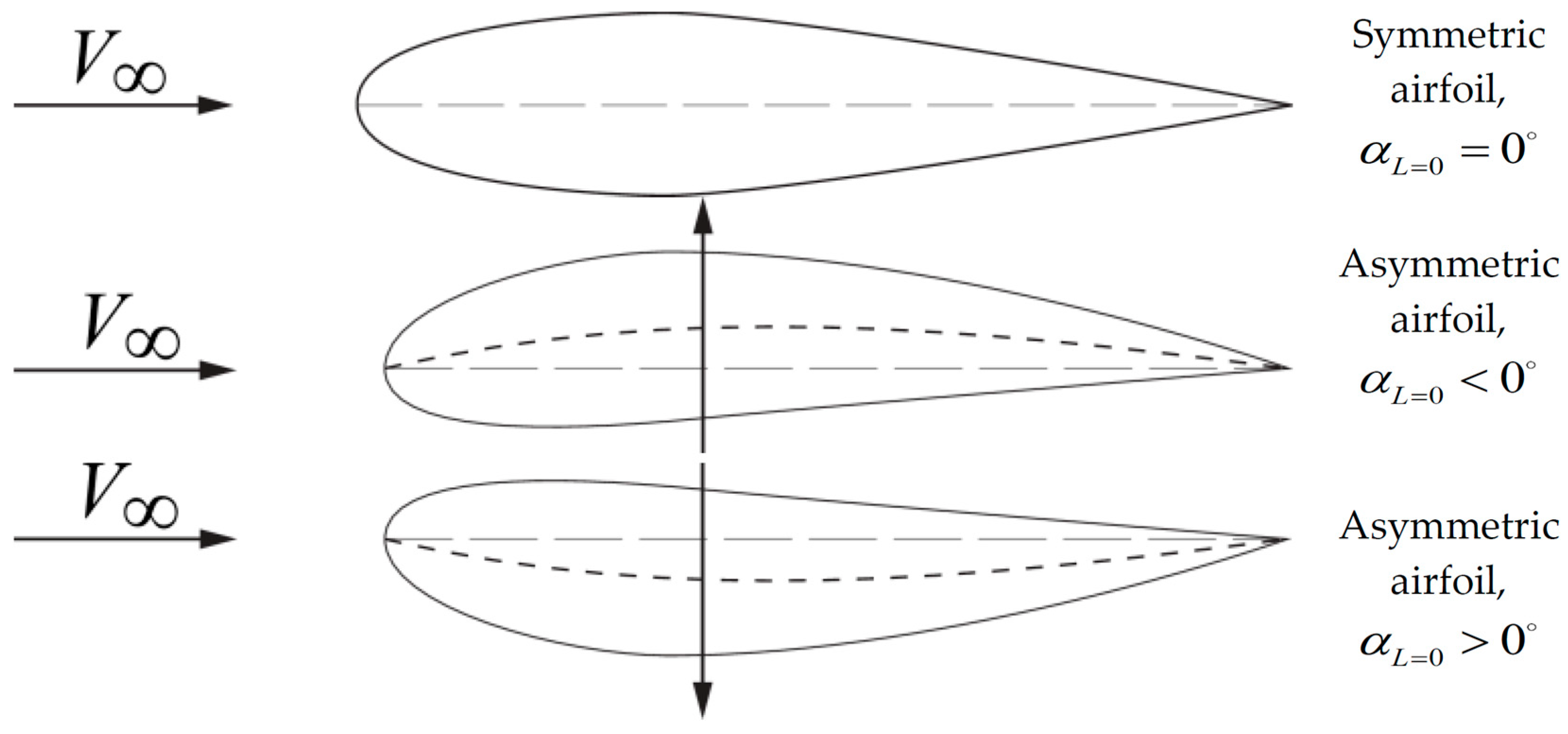
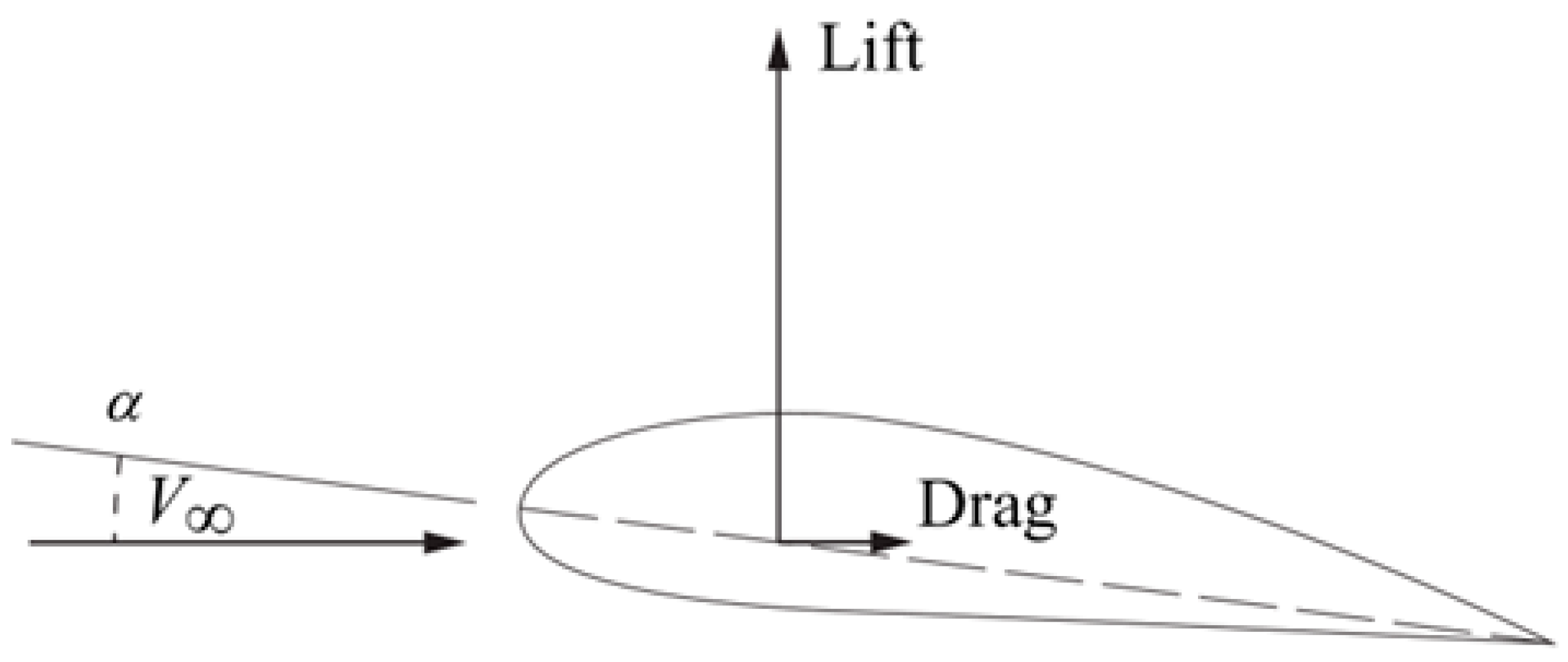
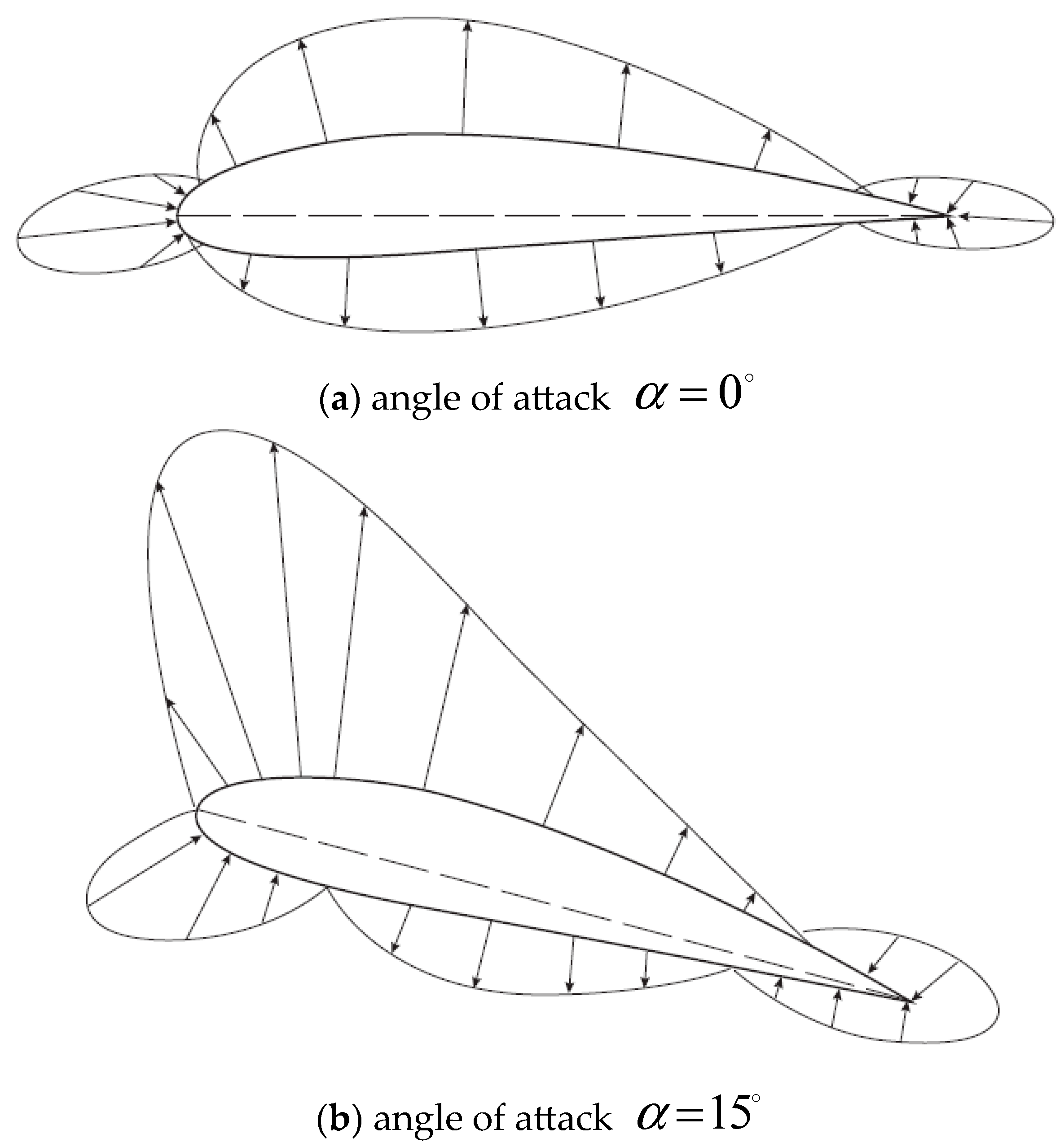


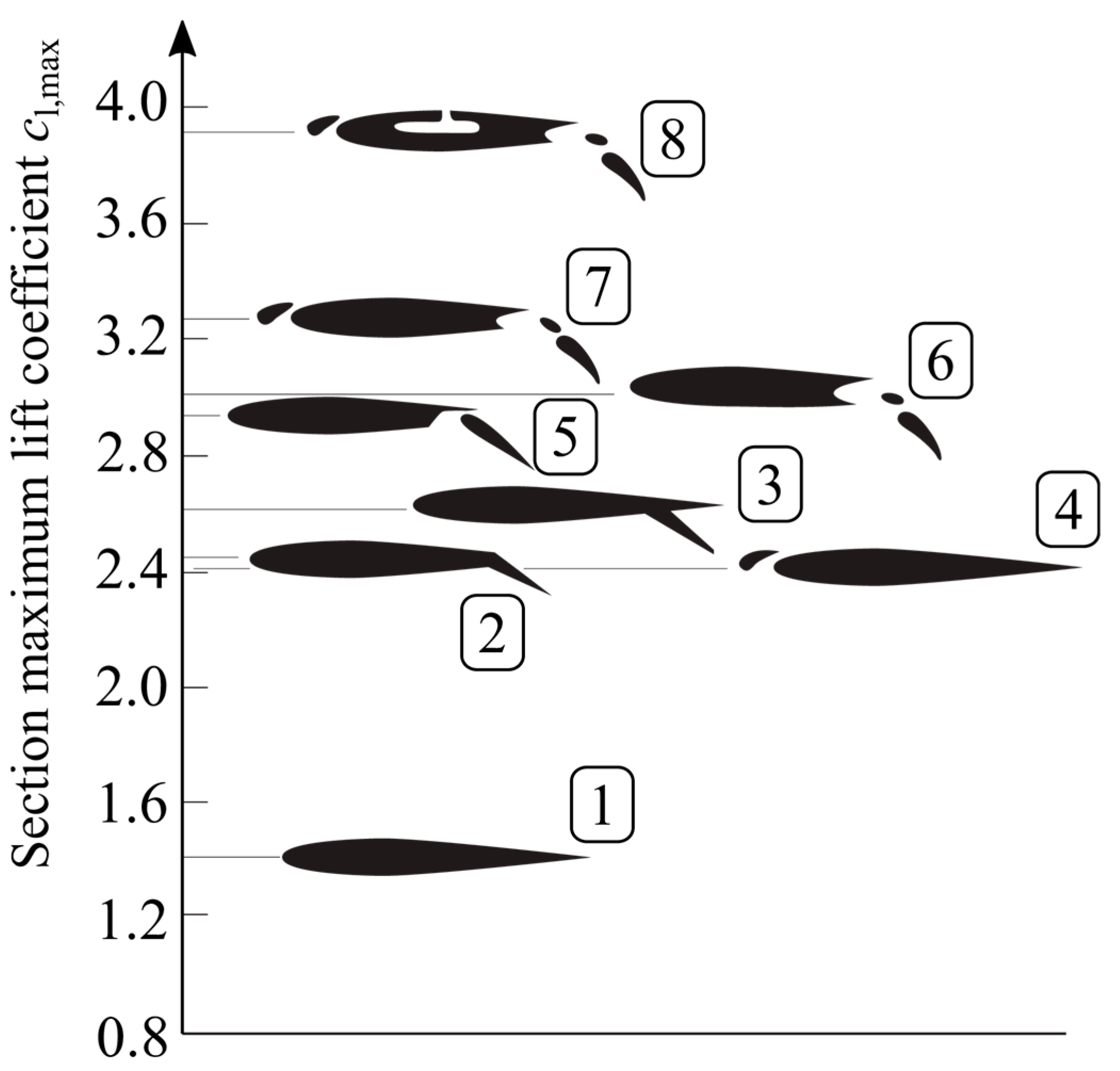
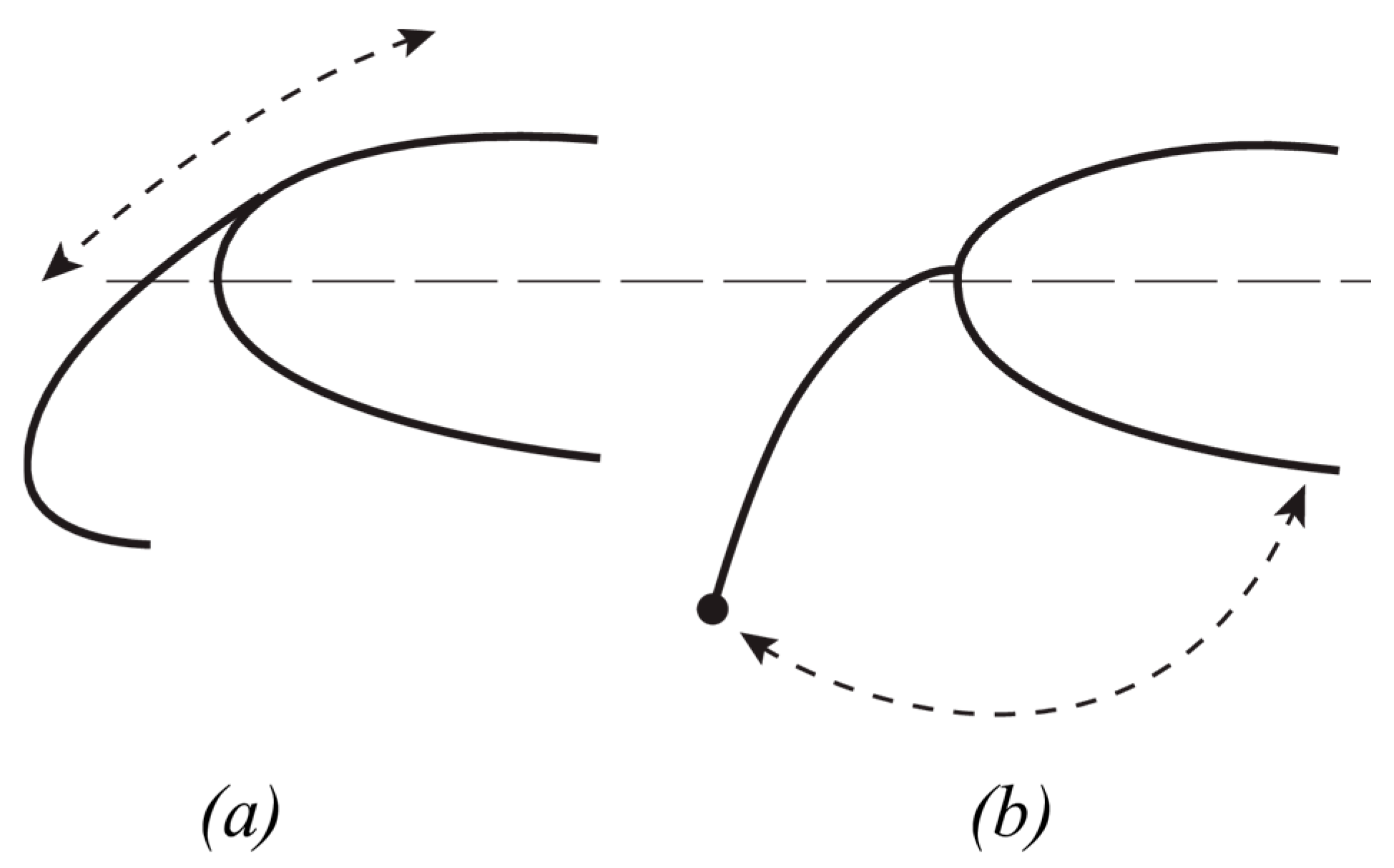
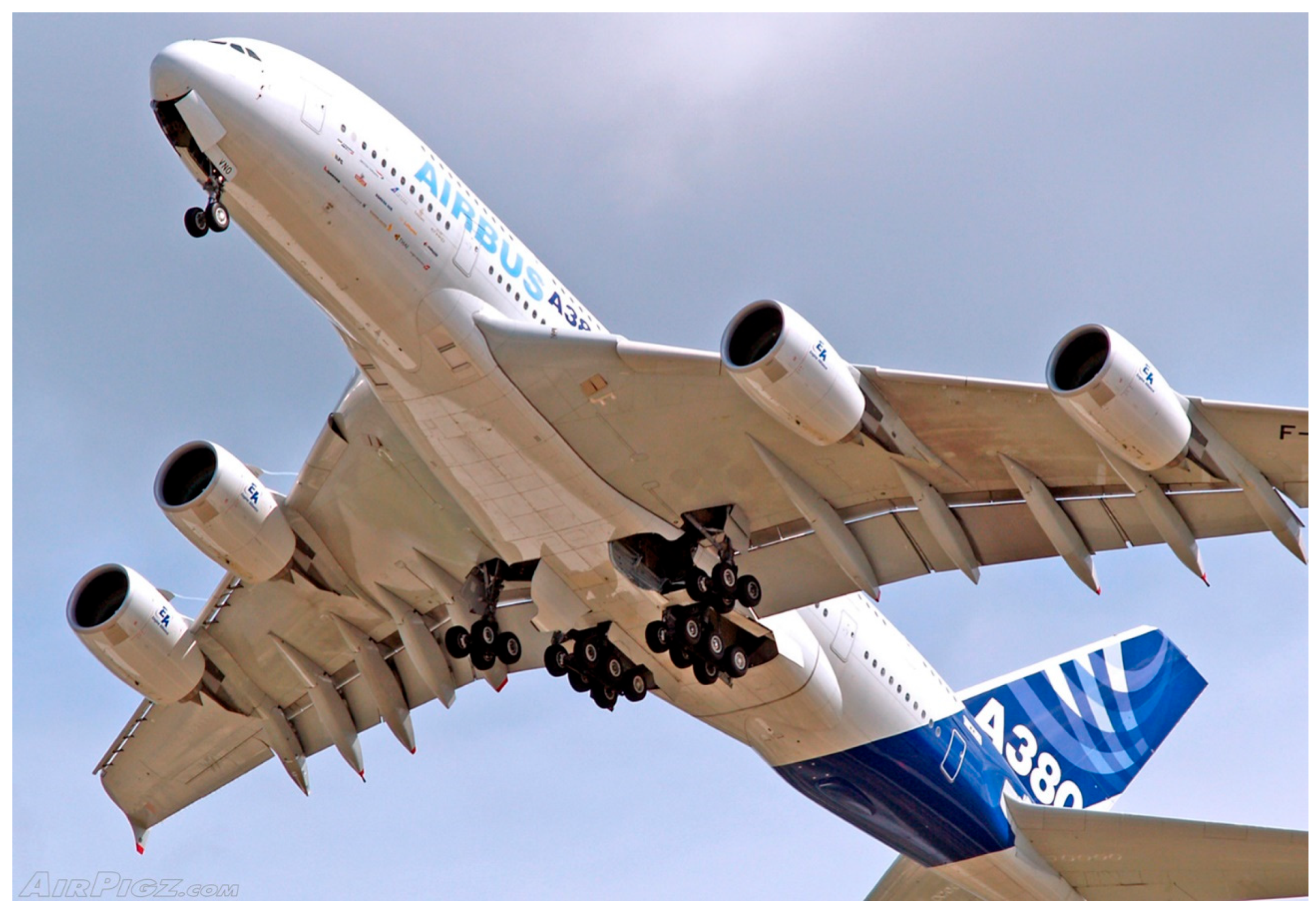


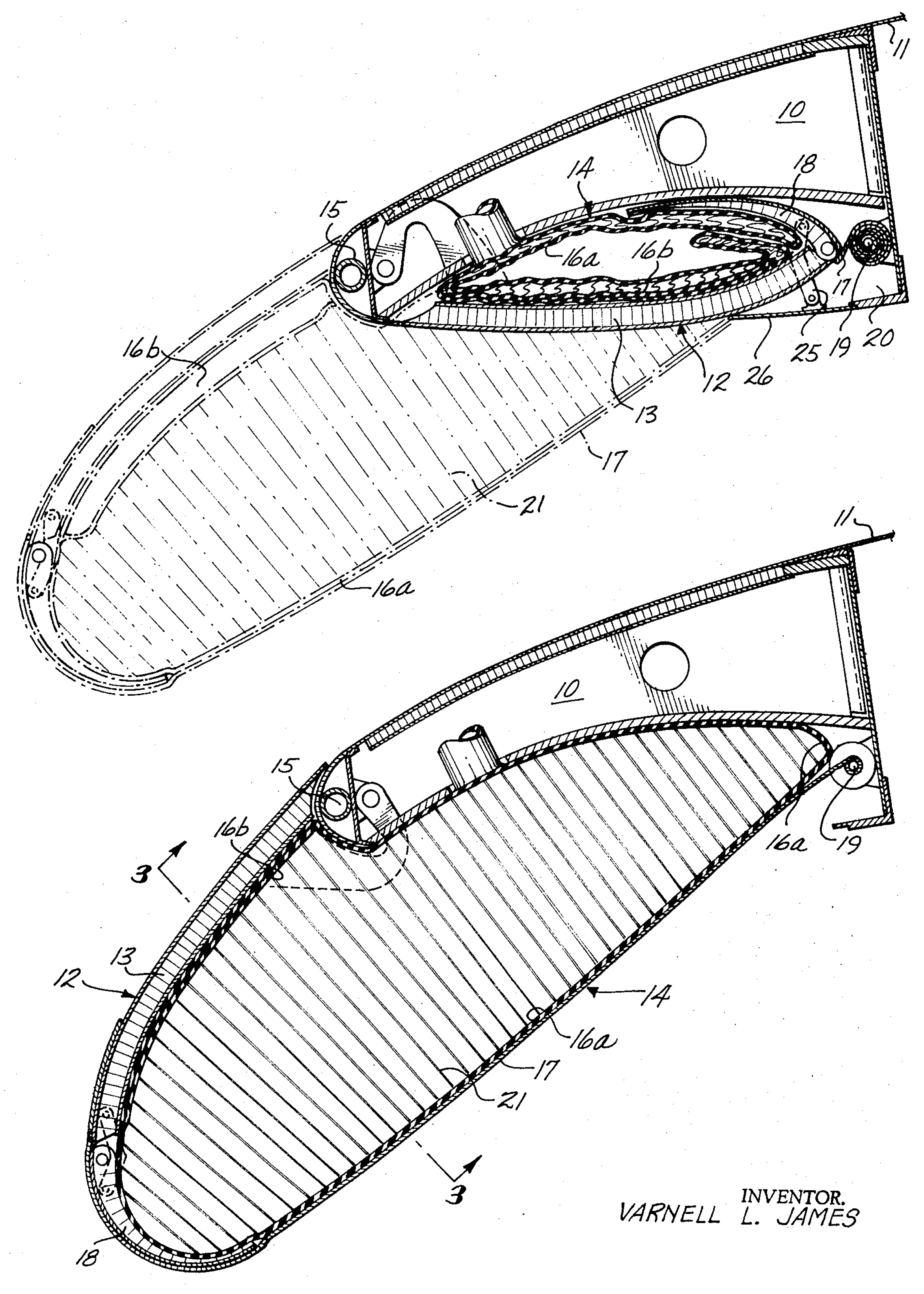

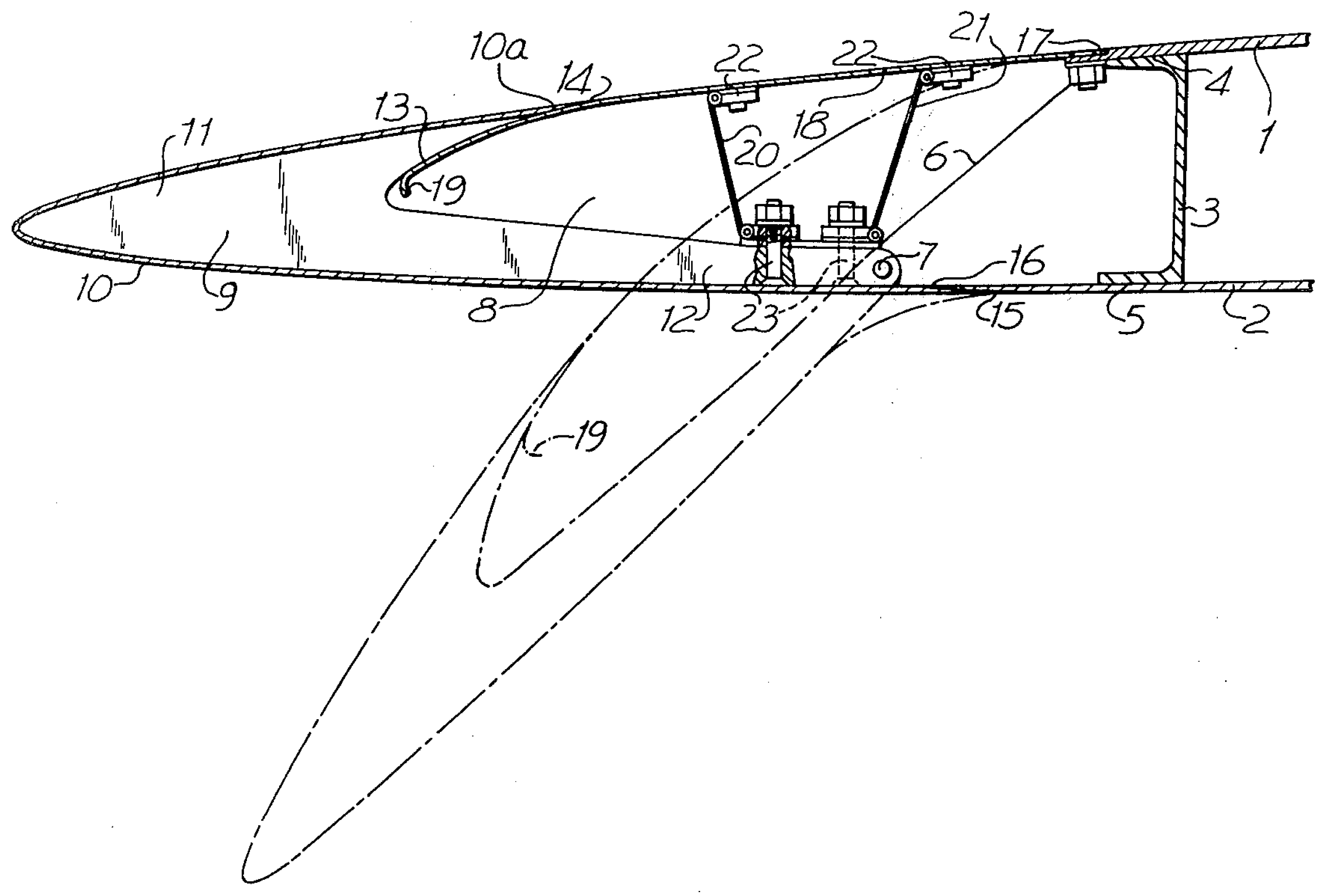
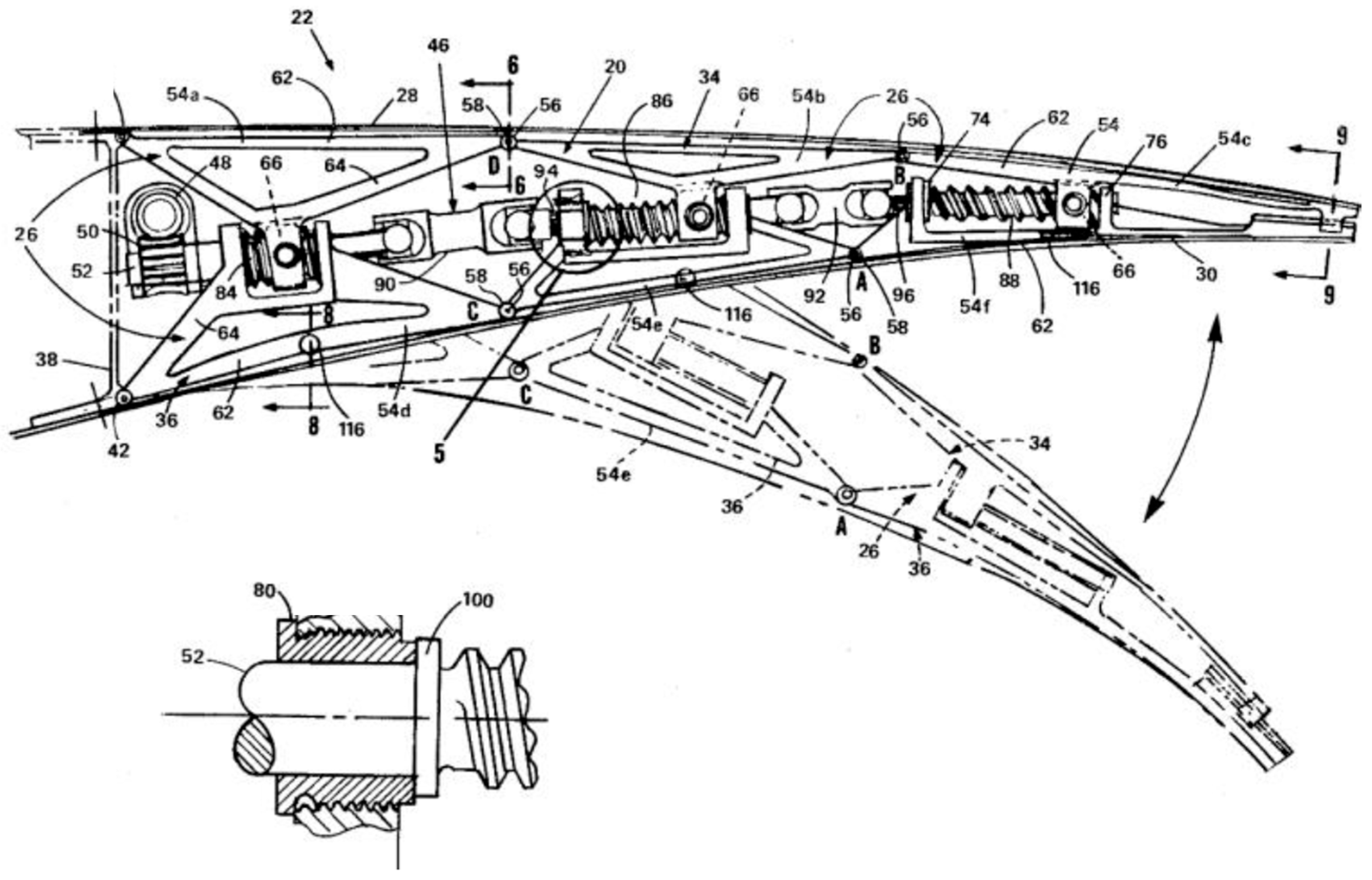


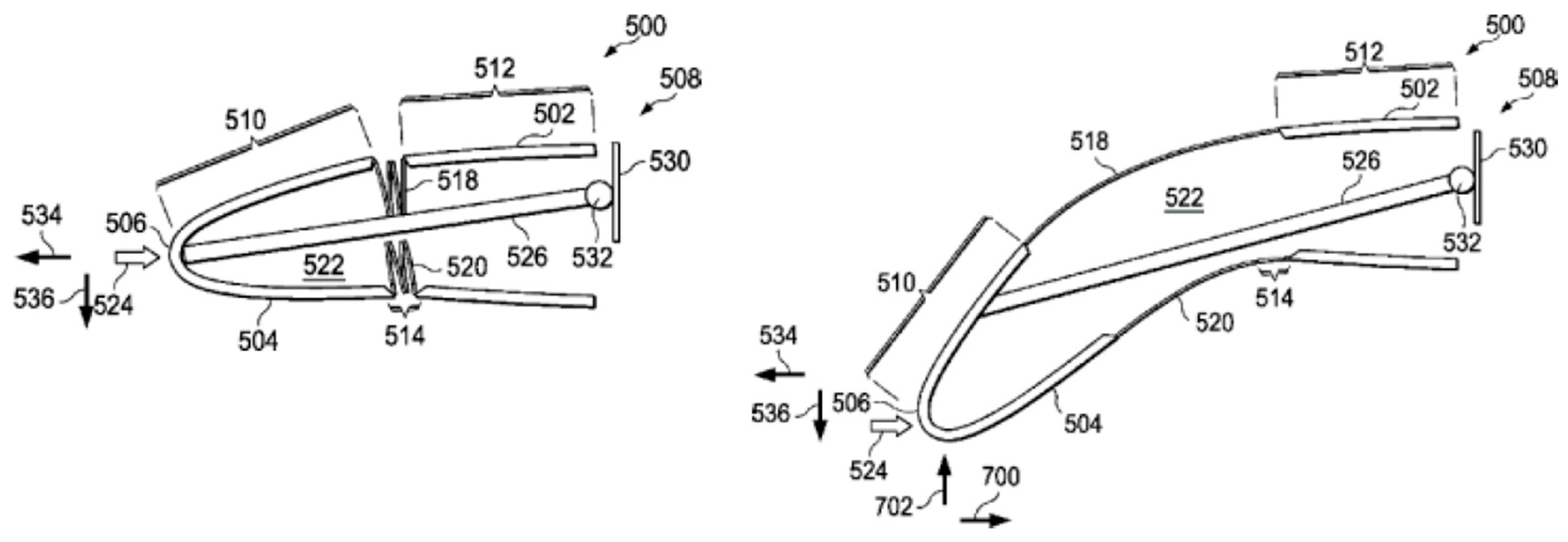




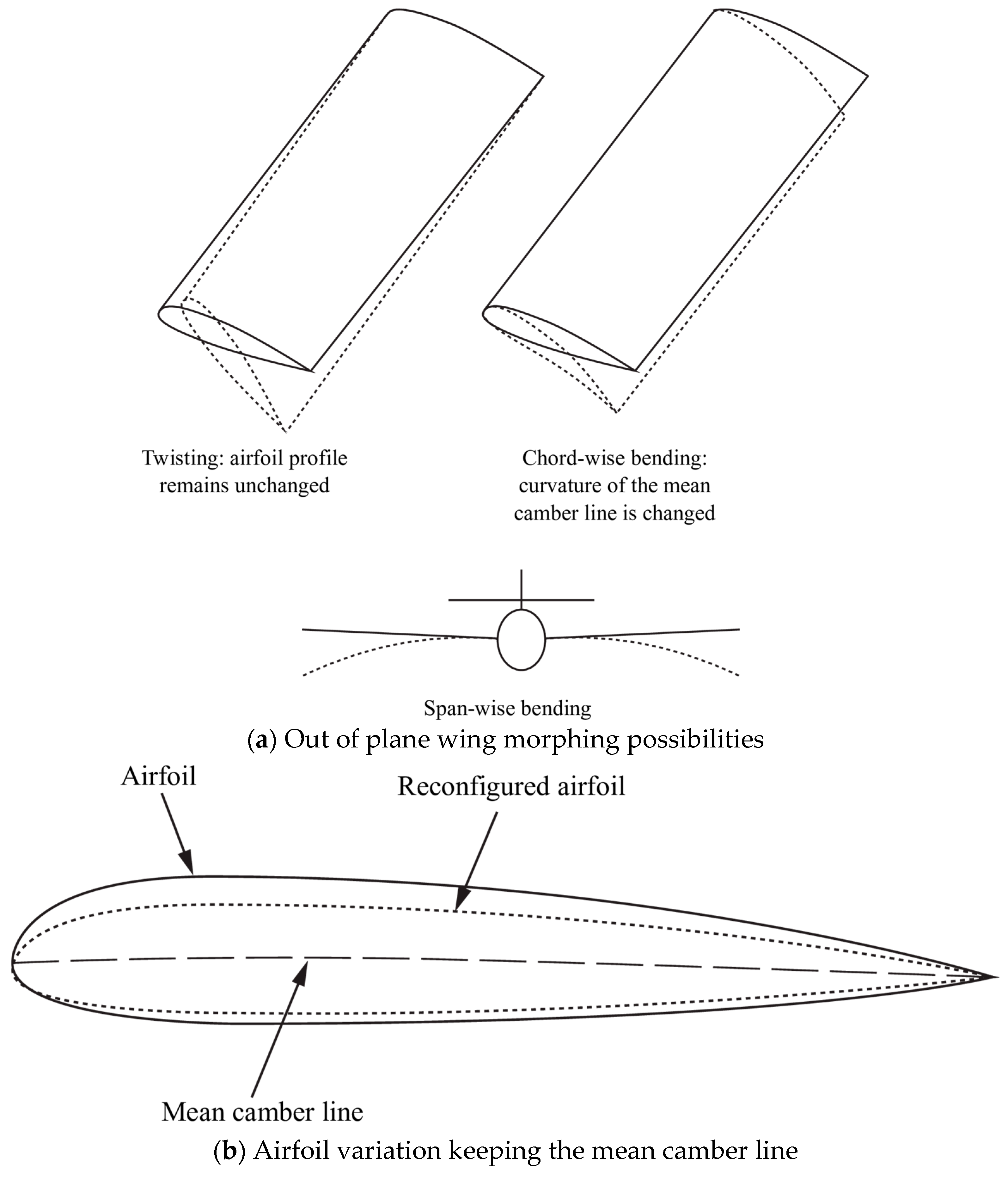
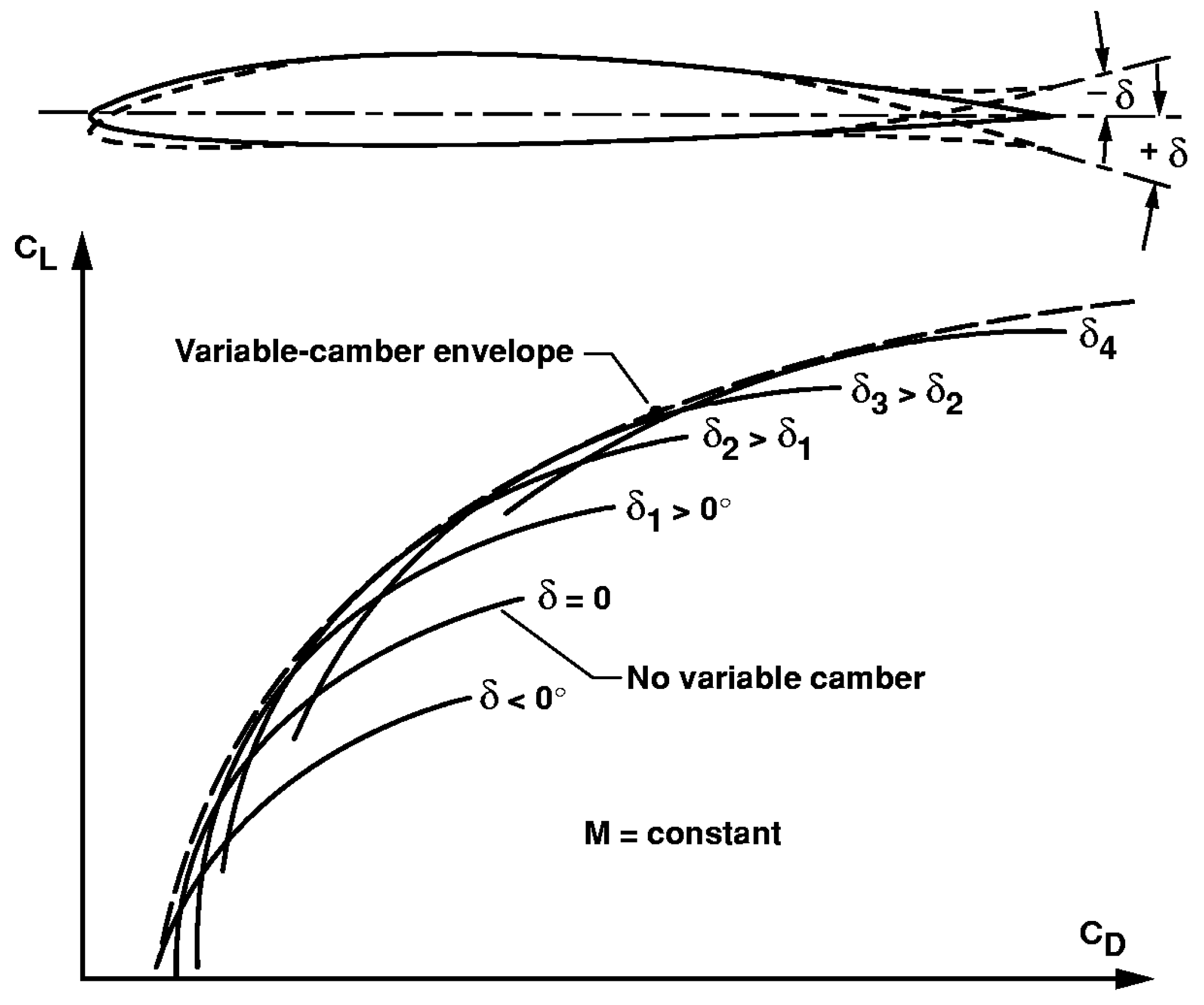
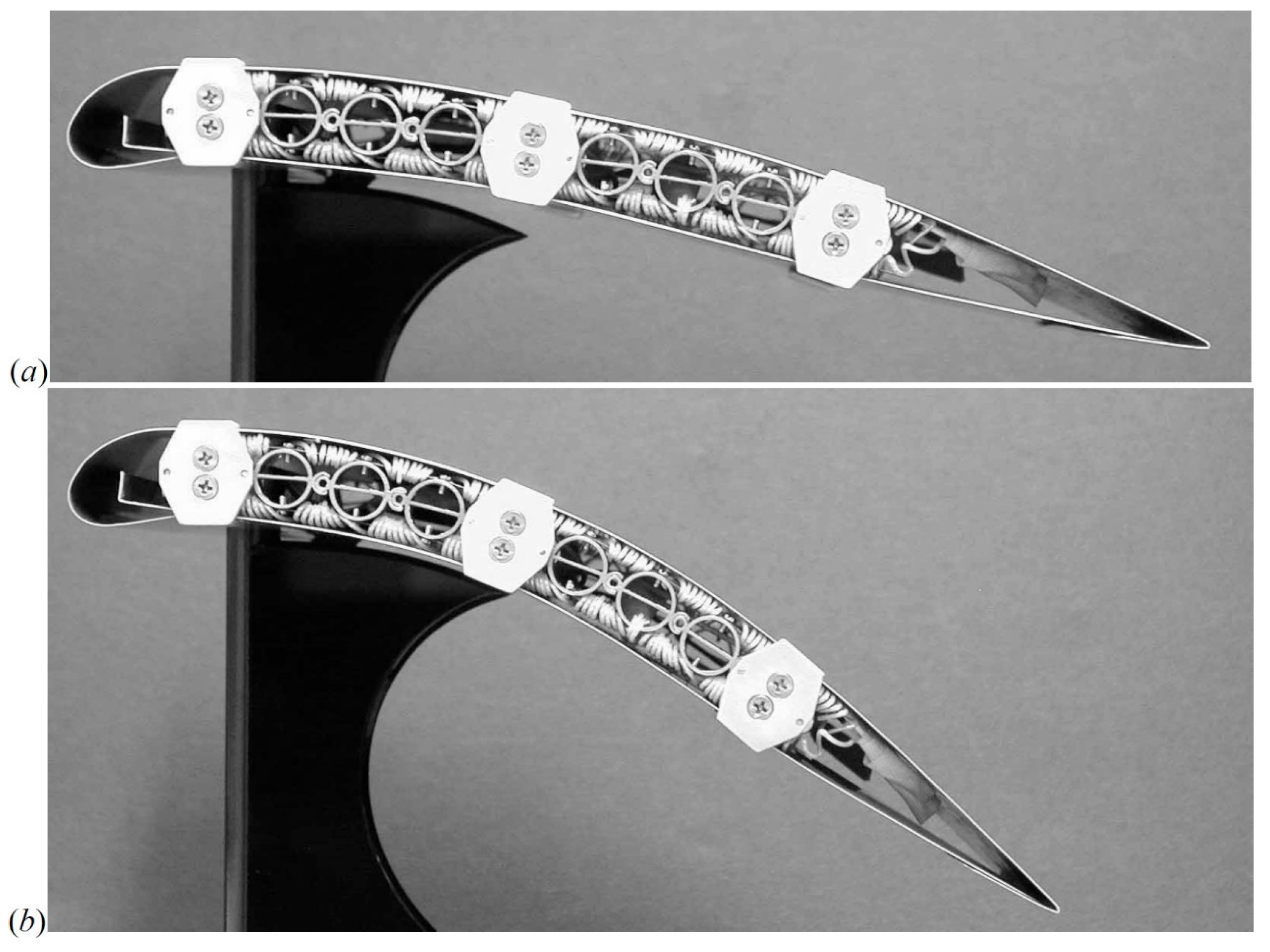


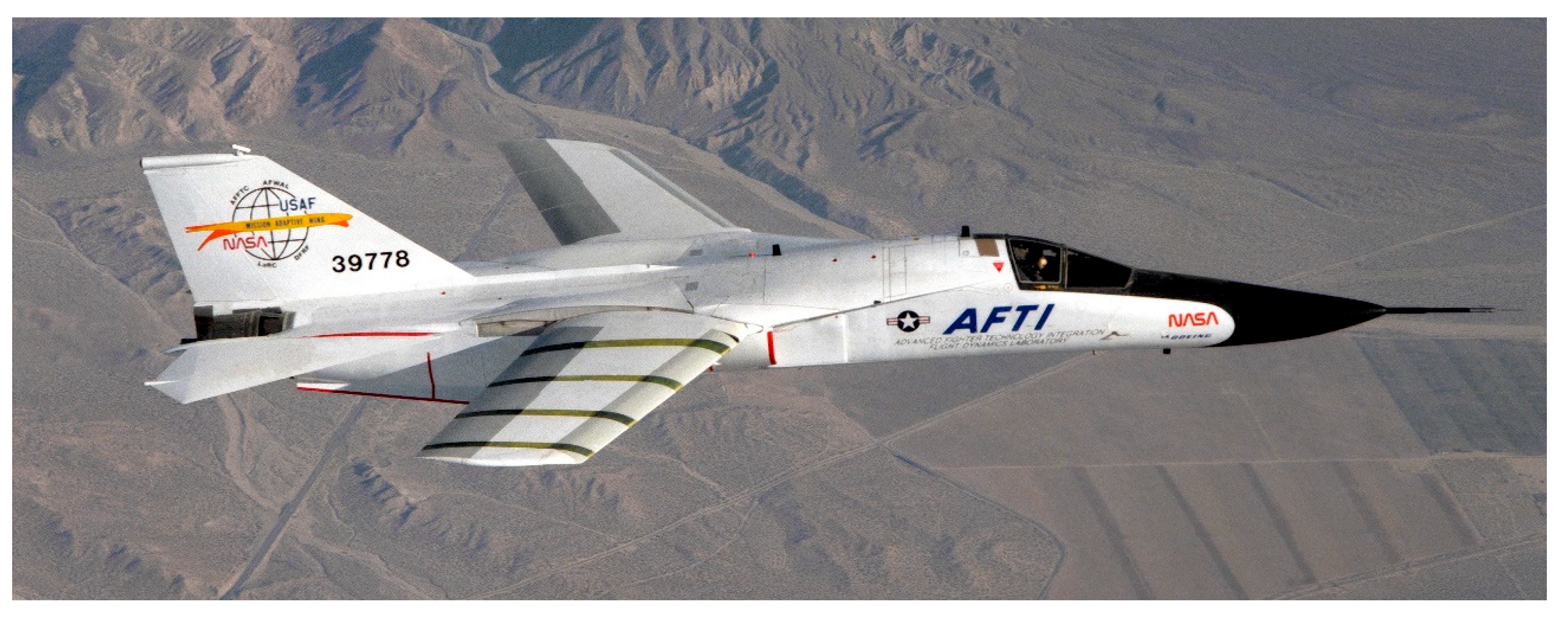


| US 3 711 039 | 1973 | Pneumatic leading edge flap for an aircraft wing |
| DE 29 07 912 A1 | 1980 | Quertriebskörper mit veränderbarer Profilierung, insbesondere Flugzeugtragfluge (airfoil with variable profile, in particular nose parts of aircraft wings)l |
| US 4 200 253 | 1980 | Aircraft wing drooping leading edge device |
| US 4 247 066 | 1981 | Airfoil variable cambering device and method |
| US 4 553 722 | 1985 | Variable-camber airfoil |
| US 4 986 493 | 1991 | Convertible fixed-wing aircraft |
| US 6 045 096 A | 2010 | Variable camber airfoil |
| US 6 213 433 B1 | 2001 | Leading edge for an aircraft |
| US 7 384 016 B2 | 2008 | Adaptive compliant wing and rotor system |
| US 2010/0 224 734 A1 | 2010 | Mechanism for changing the shape of a control surface |
| US 2012/0 104 181 A1 | 2012 | Cross-sectionally morphing airfoil |
| US 8 534 611 B1 | 2013 | Moveable leading edge device for a wing |
| EP 2 915 741 A1 | 2014 | Morphing airfoil leading edge |
| US 8 925 870 B1 | 2015 | Morphing wing leading edge |
| US 9 233 749 B1 | 2016 | Variable camber adaptive compliant wing system |
| US 2016/0 009 372 A1 | 2016 | Morphing airfoil leading edge |
| KR 101902698B1 | 2017 | Morphing wing |
| EP 3 584 154 A1 | 2019 | Aircraft wing with deployable flap |
| US 2021/0139128 A1 | 2021 | Airfoil—shaped body with a variable outer shape |
| US 11 203 409 B2 | 2021 | Geometric morphing wing with adaptive corrugated structure |
| WO 81/00 993 | 1981 | Composite leading edge for aircraft |
| EP 1 176 089 A3 | 2001 | Leading edge of aerodynamic surfaces of aircraft |
| WO 2014/081 356 A1 | 2014 | An airframe leading edge |
| WO 2014/094 549 A1 | 2014 | Aeroplane airfoil leading edge structure |
| US 2014/0 011 935 A1 | 2014 | Airfoil leading edge coatings |
| US 2015/0 298 787 A1 | 2015 | An airframe leading edge |
| US 3 282 535 | 1966 | Leading edge spoiler and flap wing stall control means |
| US 3 375 998 | 1968 | Leading edge flap and apparatus thereof |
| US 3 743 219 | 1973 | High lift leading edge device |
| US 3 743 220 | 1973 | Leading edge flap mechanism |
| US 3 831 886 | 1974 | Airfoil with extendible and retractable leading edge |
| US 3 910 530 | 1975 | Leading edge flap |
| US 4 189 120 | 1980 | Variable camber leading edge flap |
| US 4 202 519 | 1980 | Airfoil leading edge slat apparatus |
| US 4 285 482 | 1981 | Wing leading edge high lift device |
| US 4 360 176 | 1982 | Wing leading edge slat |
| EP 0 100 775 A1 | 1982 | Wing leading edge slat |
| EP 0 068 737 A1 | 1982 | Leading edge flap for an airfoil |
| US 4 398 688 | 1983 | Leading edge flap for an airfoil |
| US 4 399 970 | 1983 | Wing leading edge slat |
| US 4 422 606 | 1983 | Automatic leading edge slat for aircraft |
| US 5 158 252 | 1992 | Three-position variable camber Krueger leading edge flap |
| US 5 544 847 | 1996 | Leading edge slat/wing combination |
| US 5 839 699 | 1998 | Leading edge slat/wing combination |
| US 6 375 126 B1 | 2002 | Variable camber leading edge for an airfoil |
| US 2006/0 000 952 A1 | 2006 | Aircraft leading edge apparatuses and corresponding methods |
| US 2006/0 102 803 A1 | 2006 | Leading edge flap apparatuses and associated methods |
| US 7 270 305 B2 | 2007 | Aircraft leading edge apparatuses and corresponding methods |
| EP 1 972 547 A1 | 2007 | Wing leading edge device |
| WO 2008/084 260 A2 | 2008 | A leading edge structure for an airfoil |
| US 2009/0 072 093 A1 | 2009 | Link mechanisms for gapped rigid Krueger flaps and associated systs. and methods |
| US 7 828 250 B2 | 2010 | Leading edge flap apparatuses and associated methods |
| US 2010/0 084 515 A1 | 2010 | Leading edge structure for an airfoil |
| US 2011/0 024 575 A1 | 2011 | Leading edge flap method |
| US 7 992 826 B2 | 2011 | Leading edge flap method |
| US 8 186 630 B2 | 2012 | Leading edge structure for an airfoil |
| US 8 215 590 B2 | 2012 | Aerofoil with leading edge projection |
| US 8 534 610 B1 | 2013 | Method and apparatuses for a leading edge slat on a wing of an aircraft |
| EP 2 851 285 A1 | 2014 | Leading edge variable camber system and method |
| US 8 622 350 B1 | 2014 | Compound leading edge device for aircraft |
| US 9 169 000 B2 | 2015 | Leading edge rib assembly |
| WO2017151580A1 | 2016 | Edge morphing arrangement for an airfoil |
| US 2021/0139128 A1 | 2021 | Airfoil-shaped body with a variable outer shape |
| US 11 203 409 B2 | 2021 | Geometric morphing wing with adaptive corrugated structure |
| US 2 282 516 | 1942 | Airplane wing structure |
| US 2 289 704 | 1942 | Aircraft wing |
| US 2 333 482 | 1943 | airplane wing, aileron, and airplane rudder |
| US 2 518 854 | 1950 | Wing high lift device |
| US 3 528 632 | 1970 | High lift flaps for aircraft |
| EP 2 955 102 B1 | 2014 | Morphing trailing edge device for an airfoil |
| US 2015/0251747 A1 | 2015 | Smart material trailing edge variable chord morphing wing |
| Era | Highlights |
|---|---|
| Early concepts | Wright brothers and other pioneers |
| The mid-20th century | aerodynamics and control surfaces variable sweep wings military and experimental aircraft |
| The late 20th century | variable camber wings compliant wing technologies advanced materials |
| The 21st century and challenges | technological integration materials science, SMAs, auxetic materials, ALMs control systems weight management manufacturing issues safety, durability, maintenance and SHM economic viability usage of AI certification |
| 1906 | Wright brothers patent. |
| 1967 | F-111, introduced in 1967 after development in the 1960s, was the first production aircraft to incorporate variable-geometry wings (variable sweep wings). |
| 1979 | F-111 Mission Adaptive Wing (MAW) joint research program among Boeing, USAF, and NASA developed in the early 1980s, [143]. |
| 1995 | DLR ADIF (Adaptiver Flügel), [90]. |
| 1995 | NASA, DARPA, and US AFRL, Smart Wing project, [173]. |
| 2003–2007 | DARPA Morphing Aircraft Structures (MAS) 2003–2007 (after DARPA Smart Wing program of the late nineties), [87]. |
| 2010 | Clean Sky, and subsequent Clean Sky 2 joint undertakings (EU projects), [154], [149]. |
| 2011 | SARISTU (seeking integration of smart intelligent structural concepts), project led by AIRBUS Operations GmbH (Germany), [13,174]. |
| 2012 | CHANGE, EU project led by TEKEVER (Portugal) with Univ. Beira Interior et al., concerned with leading and trailing edges for UAVs’ morphing wings, [175]. |
| 2015 | MADCAT (NASA. MIT, Univ. California et al.): mission adaptive digital composite aerostructure technologies, [176]. |
| 2020 | Clean Aviation (EU Project), [177]. |
Disclaimer/Publisher’s Note: The statements, opinions and data contained in all publications are solely those of the individual author(s) and contributor(s) and not of MDPI and/or the editor(s). MDPI and/or the editor(s) disclaim responsibility for any injury to people or property resulting from any ideas, methods, instructions or products referred to in the content. |
© 2025 by the authors. Licensee MDPI, Basel, Switzerland. This article is an open access article distributed under the terms and conditions of the Creative Commons Attribution (CC BY) license (https://creativecommons.org/licenses/by/4.0/).
Share and Cite
Tavares, S.M.O.; Gamboa, P.V.; de Castro, P.M.S.T. Aircraft Wings and Morphing–Evolution of the Concepts. Encyclopedia 2025, 5, 101. https://doi.org/10.3390/encyclopedia5030101
Tavares SMO, Gamboa PV, de Castro PMST. Aircraft Wings and Morphing–Evolution of the Concepts. Encyclopedia. 2025; 5(3):101. https://doi.org/10.3390/encyclopedia5030101
Chicago/Turabian StyleTavares, Sérgio M. O., Pedro V. Gamboa, and Paulo M. S. T. de Castro. 2025. "Aircraft Wings and Morphing–Evolution of the Concepts" Encyclopedia 5, no. 3: 101. https://doi.org/10.3390/encyclopedia5030101
APA StyleTavares, S. M. O., Gamboa, P. V., & de Castro, P. M. S. T. (2025). Aircraft Wings and Morphing–Evolution of the Concepts. Encyclopedia, 5(3), 101. https://doi.org/10.3390/encyclopedia5030101










